Theories of Nursing
VerifiedAdded on 2023/01/16
|30
|3345
|99
Presentation
AI Summary
This presentation discusses various theories of nursing including Nightingale's Environmental Theory, Peplau's Interpersonal Relation Theory, Orlando's Deliberative Nursing Process, King's Conceptual System Theory, Roy's Adaptation Model, Transpersonal Caring Relationship, Parse's Theory, and Wiedenbach's Helping Art of Clinical Nursing. It explores the description of each theory, examples of how they apply to current practice, positive patient outcomes, benefits to nursing satisfaction, barriers to using the theory, and methods for overcoming those barriers.
Contribute Materials
Your contribution can guide someone’s learning journey. Share your
documents today.

Theories of Nursing
Name of the Student:
Name of the University:
Authors note:
Name of the Student:
Name of the University:
Authors note:
Secure Best Marks with AI Grader
Need help grading? Try our AI Grader for instant feedback on your assignments.
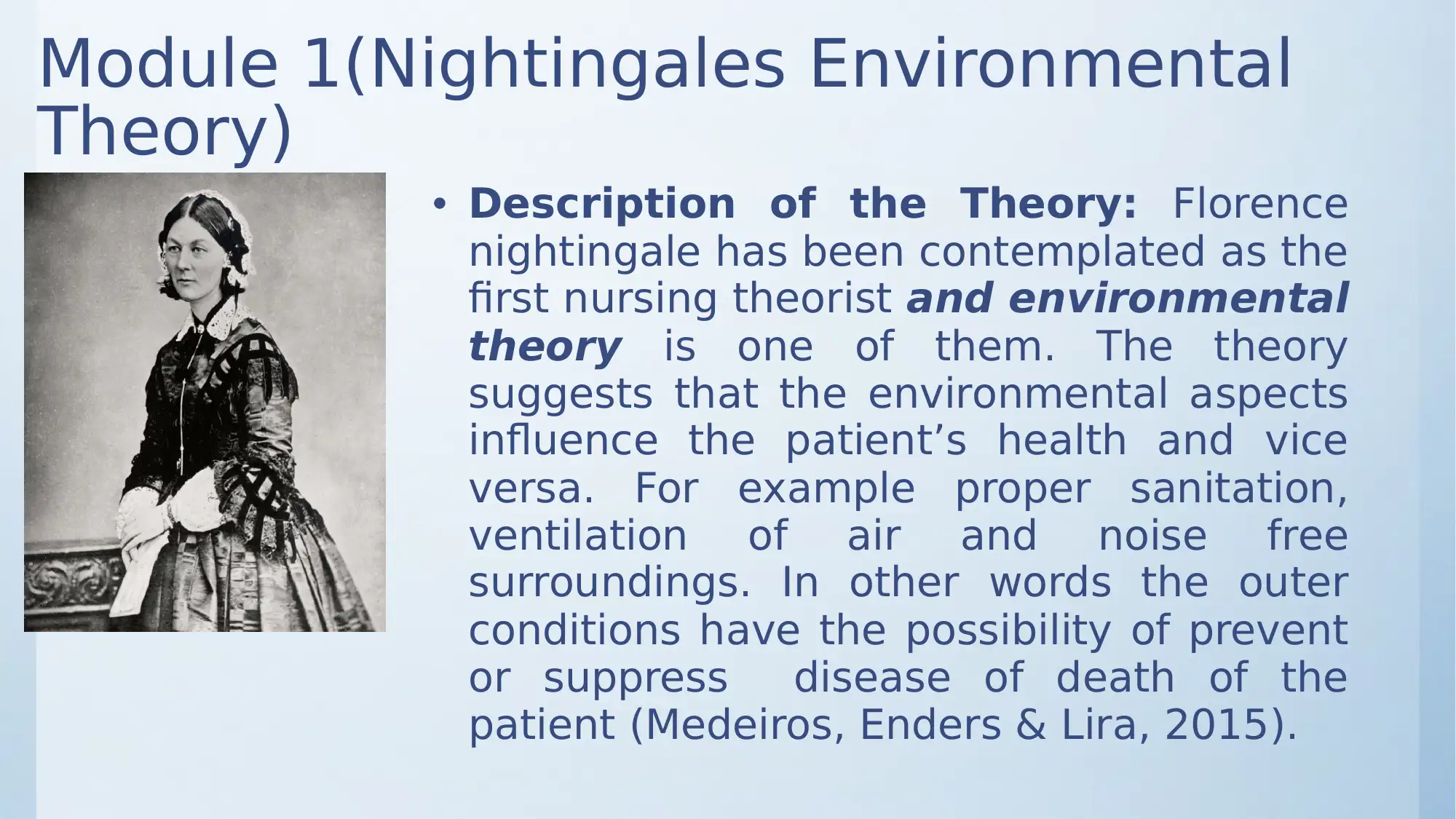
Module 1(Nightingales Environmental
Theory) • Description of the Theory: Florence
nightingale has been contemplated as the
first nursing theorist and environmental
theory is one of them. The theory
suggests that the environmental aspects
influence the patient’s health and vice
versa. For example proper sanitation,
ventilation of air and noise free
surroundings. In other words the outer
conditions have the possibility of prevent
or suppress disease of death of the
patient (Medeiros, Enders & Lira, 2015).
Theory) • Description of the Theory: Florence
nightingale has been contemplated as the
first nursing theorist and environmental
theory is one of them. The theory
suggests that the environmental aspects
influence the patient’s health and vice
versa. For example proper sanitation,
ventilation of air and noise free
surroundings. In other words the outer
conditions have the possibility of prevent
or suppress disease of death of the
patient (Medeiros, Enders & Lira, 2015).
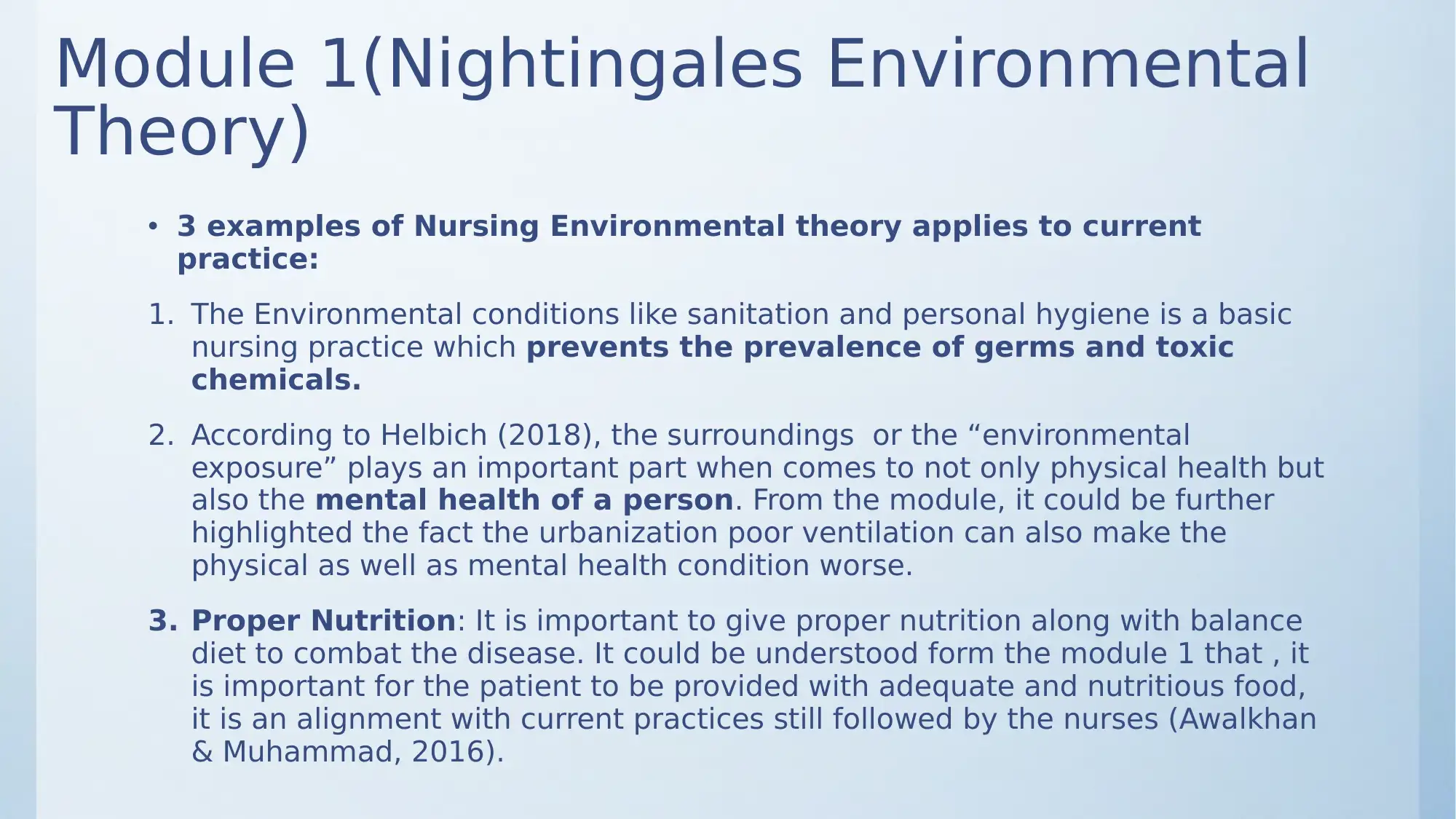
Module 1(Nightingales Environmental
Theory)
• 3 examples of Nursing Environmental theory applies to current
practice:
1. The Environmental conditions like sanitation and personal hygiene is a basic
nursing practice which prevents the prevalence of germs and toxic
chemicals.
2. According to Helbich (2018), the surroundings or the “environmental
exposure” plays an important part when comes to not only physical health but
also the mental health of a person. From the module, it could be further
highlighted the fact the urbanization poor ventilation can also make the
physical as well as mental health condition worse.
3. Proper Nutrition: It is important to give proper nutrition along with balance
diet to combat the disease. It could be understood form the module 1 that , it
is important for the patient to be provided with adequate and nutritious food,
it is an alignment with current practices still followed by the nurses (Awalkhan
& Muhammad, 2016).
Theory)
• 3 examples of Nursing Environmental theory applies to current
practice:
1. The Environmental conditions like sanitation and personal hygiene is a basic
nursing practice which prevents the prevalence of germs and toxic
chemicals.
2. According to Helbich (2018), the surroundings or the “environmental
exposure” plays an important part when comes to not only physical health but
also the mental health of a person. From the module, it could be further
highlighted the fact the urbanization poor ventilation can also make the
physical as well as mental health condition worse.
3. Proper Nutrition: It is important to give proper nutrition along with balance
diet to combat the disease. It could be understood form the module 1 that , it
is important for the patient to be provided with adequate and nutritious food,
it is an alignment with current practices still followed by the nurses (Awalkhan
& Muhammad, 2016).
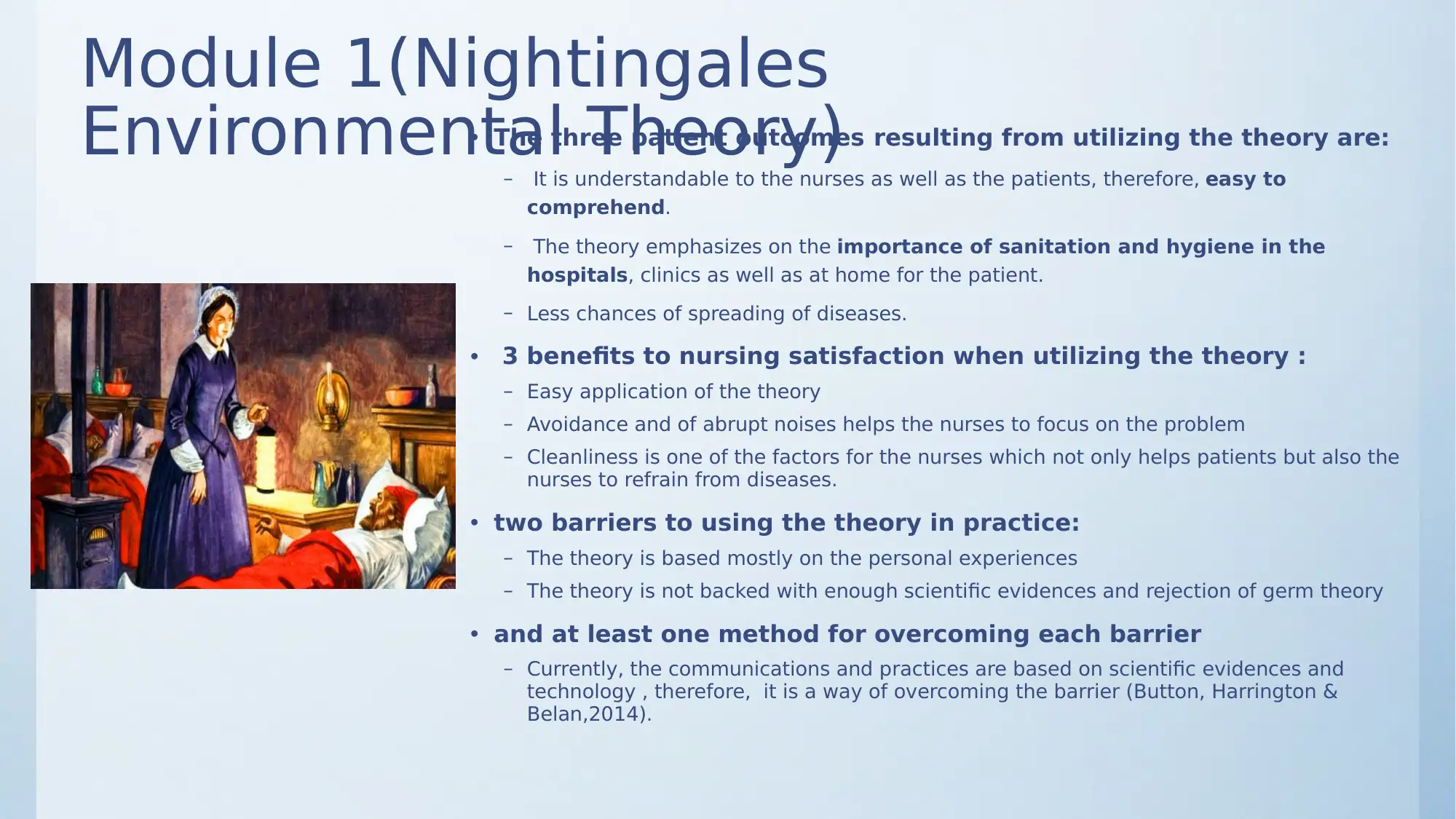
Module 1(Nightingales
Environmental Theory)• The three patient outcomes resulting from utilizing the theory are:
– It is understandable to the nurses as well as the patients, therefore, easy to
comprehend.
– The theory emphasizes on the importance of sanitation and hygiene in the
hospitals, clinics as well as at home for the patient.
– Less chances of spreading of diseases.
• 3 benefits to nursing satisfaction when utilizing the theory :
– Easy application of the theory
– Avoidance and of abrupt noises helps the nurses to focus on the problem
– Cleanliness is one of the factors for the nurses which not only helps patients but also the
nurses to refrain from diseases.
• two barriers to using the theory in practice:
– The theory is based mostly on the personal experiences
– The theory is not backed with enough scientific evidences and rejection of germ theory
• and at least one method for overcoming each barrier
– Currently, the communications and practices are based on scientific evidences and
technology , therefore, it is a way of overcoming the barrier (Button, Harrington &
Belan,2014).
Environmental Theory)• The three patient outcomes resulting from utilizing the theory are:
– It is understandable to the nurses as well as the patients, therefore, easy to
comprehend.
– The theory emphasizes on the importance of sanitation and hygiene in the
hospitals, clinics as well as at home for the patient.
– Less chances of spreading of diseases.
• 3 benefits to nursing satisfaction when utilizing the theory :
– Easy application of the theory
– Avoidance and of abrupt noises helps the nurses to focus on the problem
– Cleanliness is one of the factors for the nurses which not only helps patients but also the
nurses to refrain from diseases.
• two barriers to using the theory in practice:
– The theory is based mostly on the personal experiences
– The theory is not backed with enough scientific evidences and rejection of germ theory
• and at least one method for overcoming each barrier
– Currently, the communications and practices are based on scientific evidences and
technology , therefore, it is a way of overcoming the barrier (Button, Harrington &
Belan,2014).
Secure Best Marks with AI Grader
Need help grading? Try our AI Grader for instant feedback on your assignments.
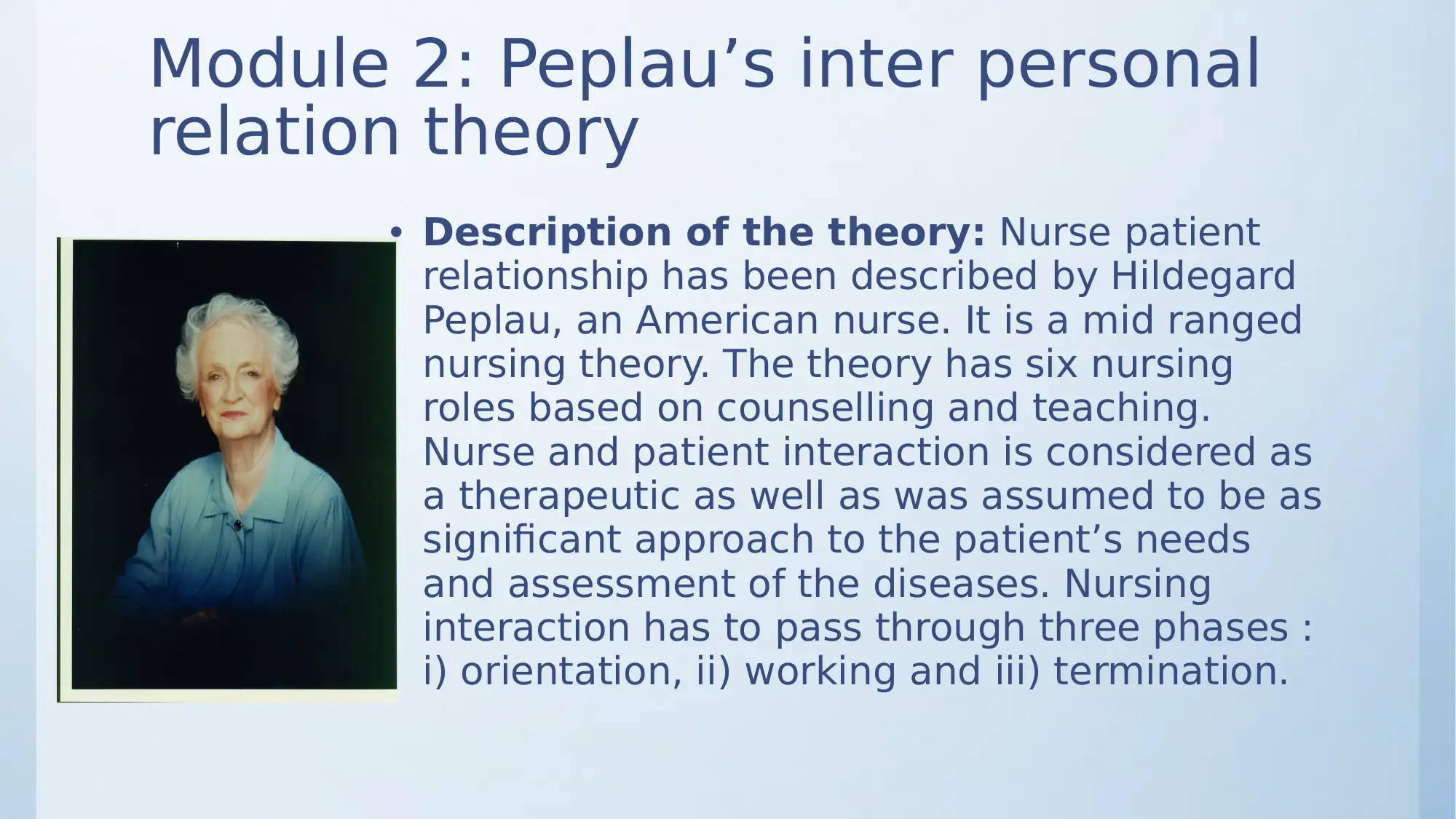
Module 2: Peplau’s inter personal
relation theory
• Description of the theory: Nurse patient
relationship has been described by Hildegard
Peplau, an American nurse. It is a mid ranged
nursing theory. The theory has six nursing
roles based on counselling and teaching.
Nurse and patient interaction is considered as
a therapeutic as well as was assumed to be as
significant approach to the patient’s needs
and assessment of the diseases. Nursing
interaction has to pass through three phases :
i) orientation, ii) working and iii) termination.
relation theory
• Description of the theory: Nurse patient
relationship has been described by Hildegard
Peplau, an American nurse. It is a mid ranged
nursing theory. The theory has six nursing
roles based on counselling and teaching.
Nurse and patient interaction is considered as
a therapeutic as well as was assumed to be as
significant approach to the patient’s needs
and assessment of the diseases. Nursing
interaction has to pass through three phases :
i) orientation, ii) working and iii) termination.

Module 2: Peplau’s interpersonal
relation theory
3 examples of how the theory applies to current practice:
1. Current nursing practice focuses on patient based approach
where it is required for the nurse to understand the patient’s
cultural as well as emotional state.
2. Globally the stress is increasing day by day therefore, the
importance of positive nurse to patient communication is very
important for the organizational strategies (Wong, Cummings &
Ducharme,2013).
3. Patient education is an important part of nursing practice as
well as helps in patient satisfaction (Radtke, 2013).
relation theory
3 examples of how the theory applies to current practice:
1. Current nursing practice focuses on patient based approach
where it is required for the nurse to understand the patient’s
cultural as well as emotional state.
2. Globally the stress is increasing day by day therefore, the
importance of positive nurse to patient communication is very
important for the organizational strategies (Wong, Cummings &
Ducharme,2013).
3. Patient education is an important part of nursing practice as
well as helps in patient satisfaction (Radtke, 2013).
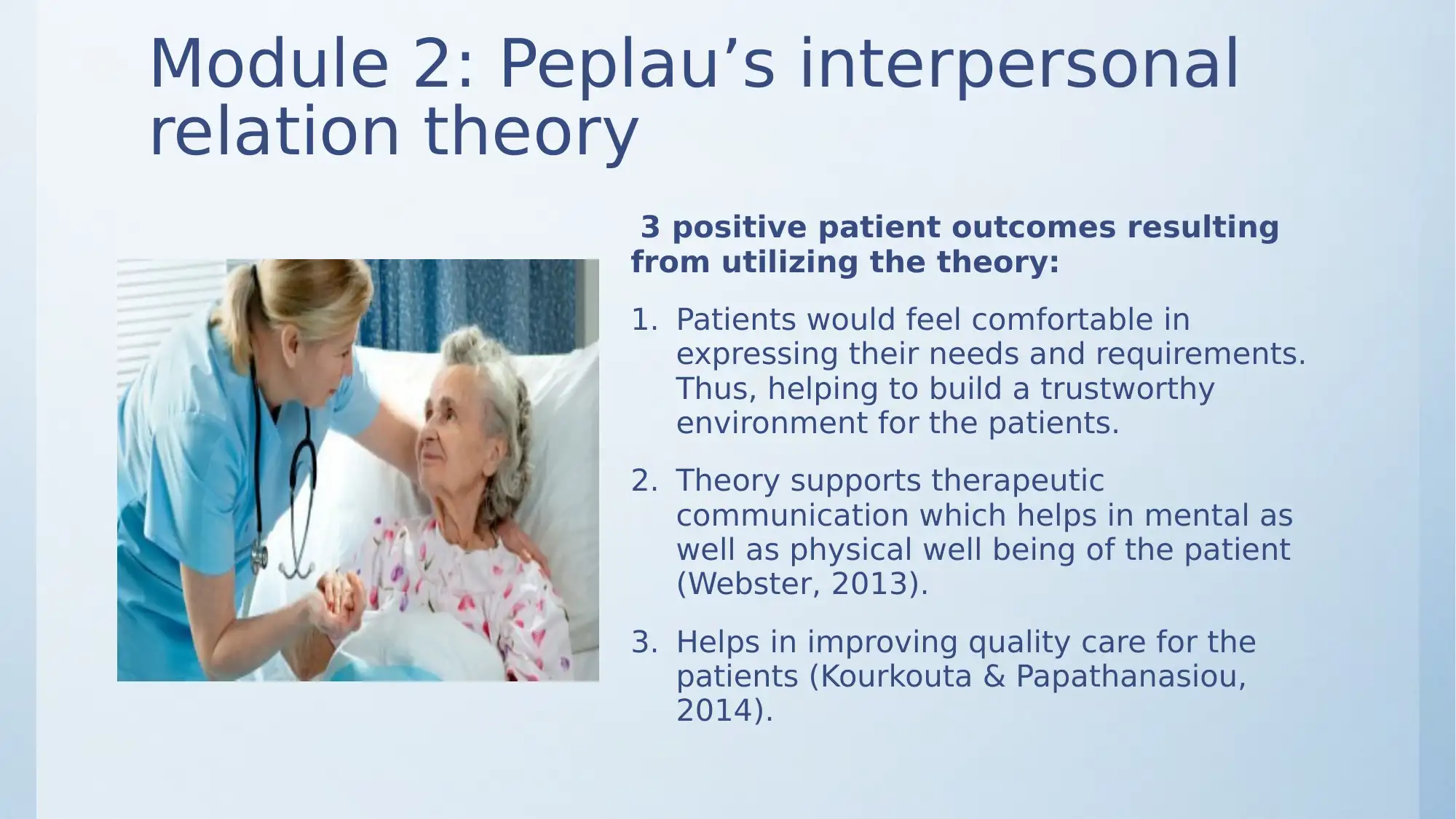
Module 2: Peplau’s interpersonal
relation theory
3 positive patient outcomes resulting
from utilizing the theory:
1. Patients would feel comfortable in
expressing their needs and requirements.
Thus, helping to build a trustworthy
environment for the patients.
2. Theory supports therapeutic
communication which helps in mental as
well as physical well being of the patient
(Webster, 2013).
3. Helps in improving quality care for the
patients (Kourkouta & Papathanasiou,
2014).
relation theory
3 positive patient outcomes resulting
from utilizing the theory:
1. Patients would feel comfortable in
expressing their needs and requirements.
Thus, helping to build a trustworthy
environment for the patients.
2. Theory supports therapeutic
communication which helps in mental as
well as physical well being of the patient
(Webster, 2013).
3. Helps in improving quality care for the
patients (Kourkouta & Papathanasiou,
2014).
Paraphrase This Document
Need a fresh take? Get an instant paraphrase of this document with our AI Paraphraser
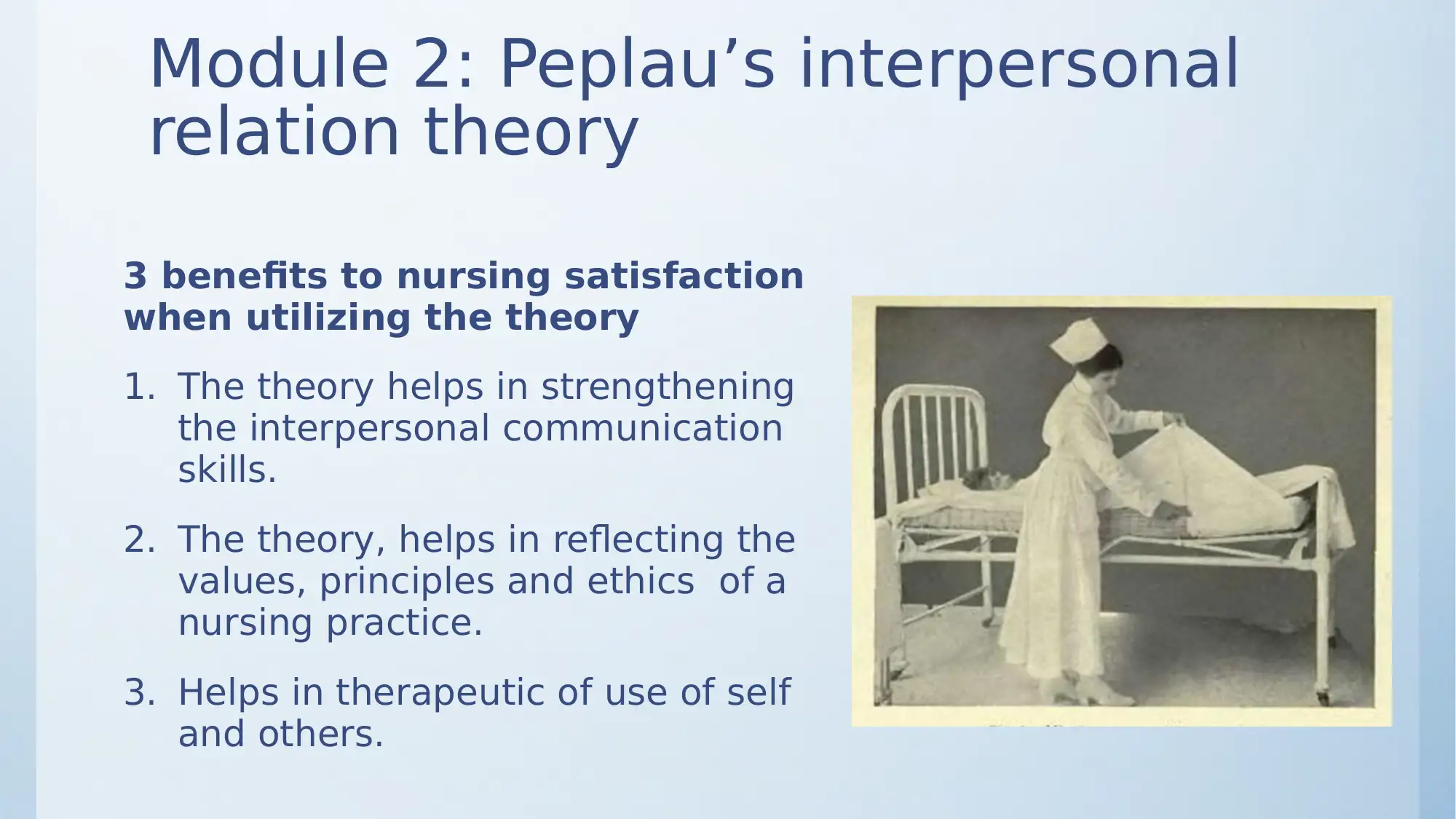
Module 2: Peplau’s interpersonal
relation theory
3 benefits to nursing satisfaction
when utilizing the theory
1. The theory helps in strengthening
the interpersonal communication
skills.
2. The theory, helps in reflecting the
values, principles and ethics of a
nursing practice.
3. Helps in therapeutic of use of self
and others.
relation theory
3 benefits to nursing satisfaction
when utilizing the theory
1. The theory helps in strengthening
the interpersonal communication
skills.
2. The theory, helps in reflecting the
values, principles and ethics of a
nursing practice.
3. Helps in therapeutic of use of self
and others.
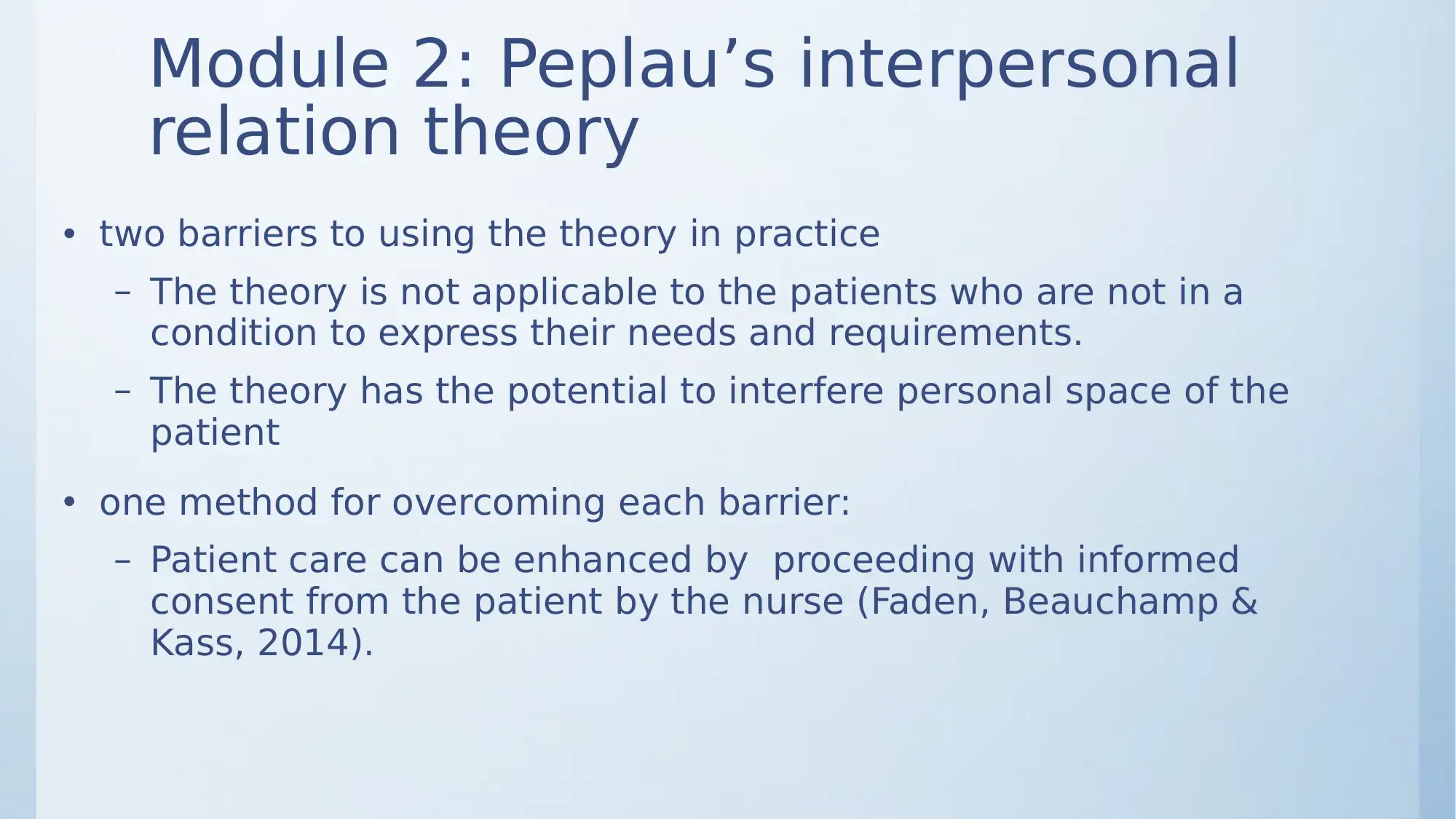
Module 2: Peplau’s interpersonal
relation theory
• two barriers to using the theory in practice
– The theory is not applicable to the patients who are not in a
condition to express their needs and requirements.
– The theory has the potential to interfere personal space of the
patient
• one method for overcoming each barrier:
– Patient care can be enhanced by proceeding with informed
consent from the patient by the nurse (Faden, Beauchamp &
Kass, 2014).
relation theory
• two barriers to using the theory in practice
– The theory is not applicable to the patients who are not in a
condition to express their needs and requirements.
– The theory has the potential to interfere personal space of the
patient
• one method for overcoming each barrier:
– Patient care can be enhanced by proceeding with informed
consent from the patient by the nurse (Faden, Beauchamp &
Kass, 2014).
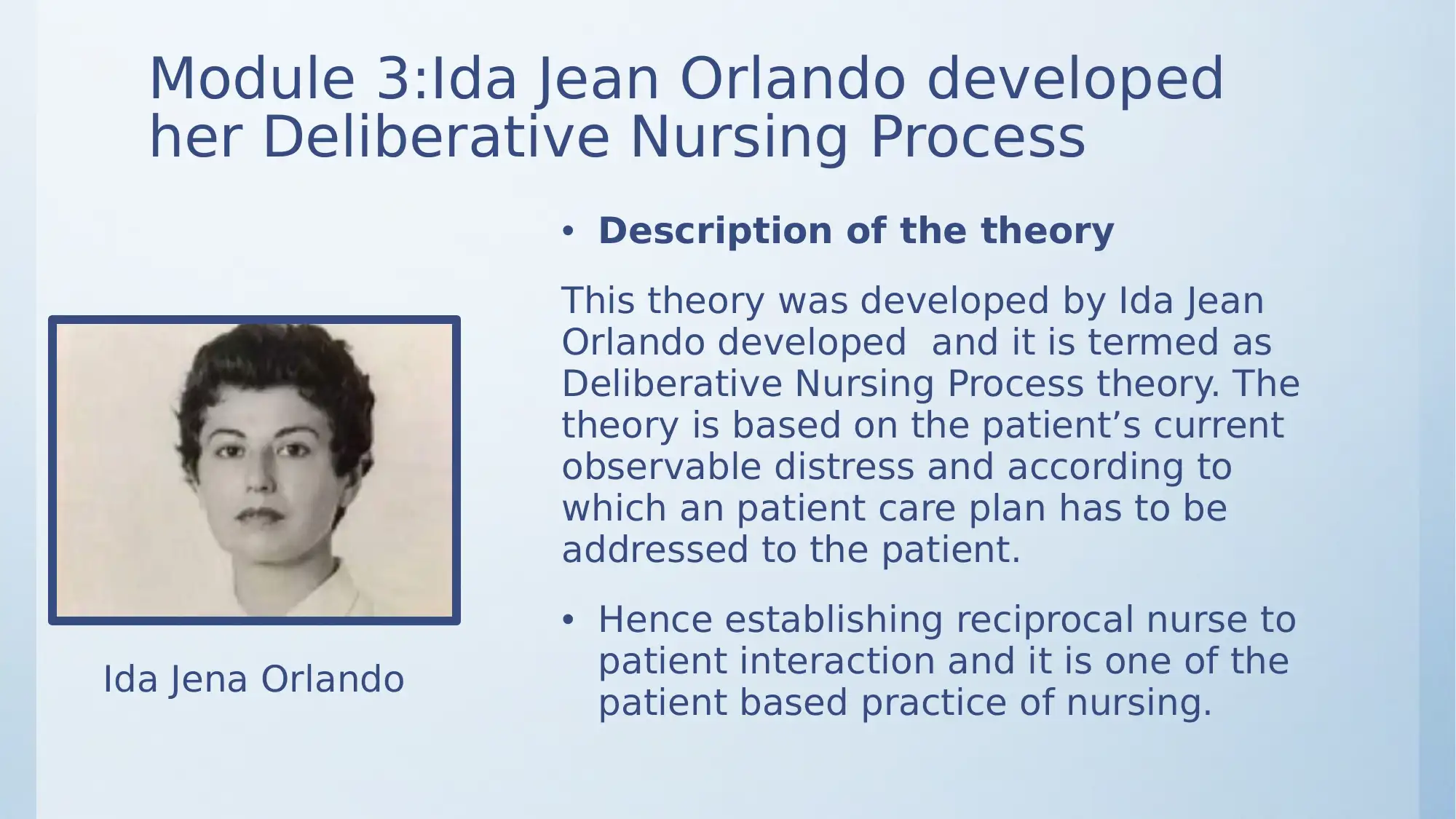
Module 3:Ida Jean Orlando developed
her Deliberative Nursing Process
• Description of the theory
This theory was developed by Ida Jean
Orlando developed and it is termed as
Deliberative Nursing Process theory. The
theory is based on the patient’s current
observable distress and according to
which an patient care plan has to be
addressed to the patient.
• Hence establishing reciprocal nurse to
patient interaction and it is one of the
patient based practice of nursing.
Ida Jena Orlando
her Deliberative Nursing Process
• Description of the theory
This theory was developed by Ida Jean
Orlando developed and it is termed as
Deliberative Nursing Process theory. The
theory is based on the patient’s current
observable distress and according to
which an patient care plan has to be
addressed to the patient.
• Hence establishing reciprocal nurse to
patient interaction and it is one of the
patient based practice of nursing.
Ida Jena Orlando
Secure Best Marks with AI Grader
Need help grading? Try our AI Grader for instant feedback on your assignments.
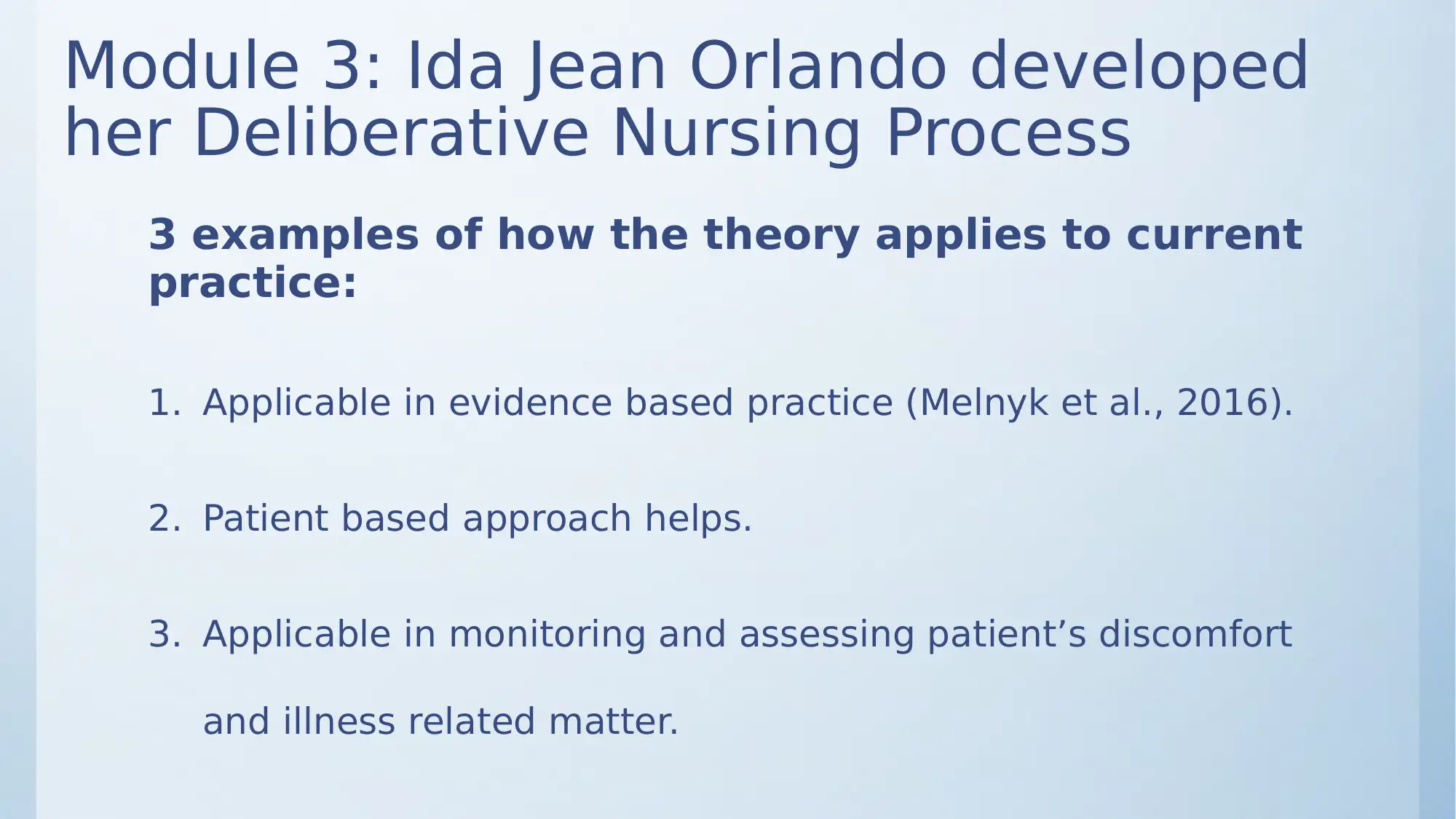
Module 3: Ida Jean Orlando developed
her Deliberative Nursing Process
3 examples of how the theory applies to current
practice:
1. Applicable in evidence based practice (Melnyk et al., 2016).
2. Patient based approach helps.
3. Applicable in monitoring and assessing patient’s discomfort
and illness related matter.
her Deliberative Nursing Process
3 examples of how the theory applies to current
practice:
1. Applicable in evidence based practice (Melnyk et al., 2016).
2. Patient based approach helps.
3. Applicable in monitoring and assessing patient’s discomfort
and illness related matter.
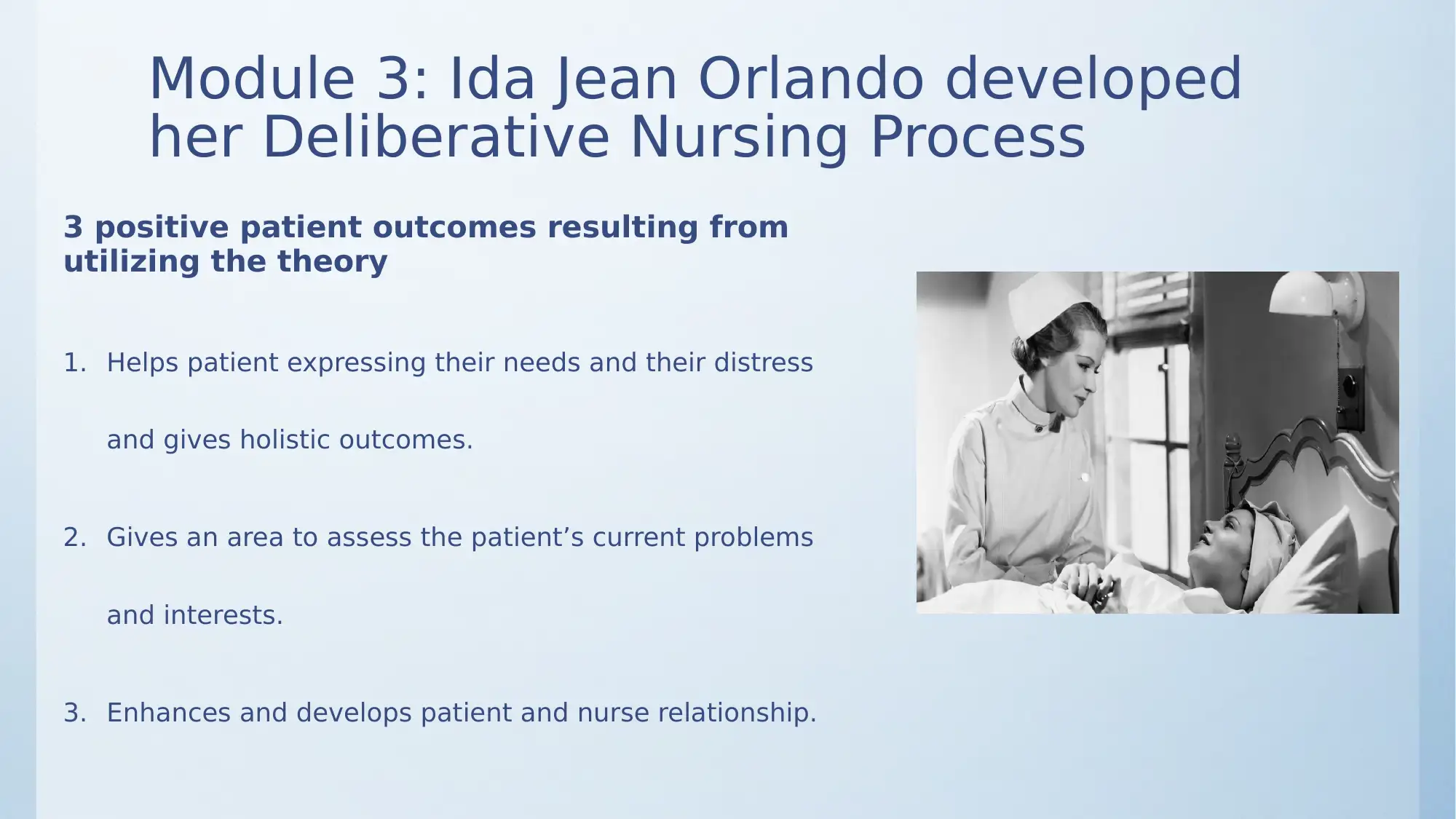
Module 3: Ida Jean Orlando developed
her Deliberative Nursing Process
3 positive patient outcomes resulting from
utilizing the theory
1. Helps patient expressing their needs and their distress
and gives holistic outcomes.
2. Gives an area to assess the patient’s current problems
and interests.
3. Enhances and develops patient and nurse relationship.
her Deliberative Nursing Process
3 positive patient outcomes resulting from
utilizing the theory
1. Helps patient expressing their needs and their distress
and gives holistic outcomes.
2. Gives an area to assess the patient’s current problems
and interests.
3. Enhances and develops patient and nurse relationship.
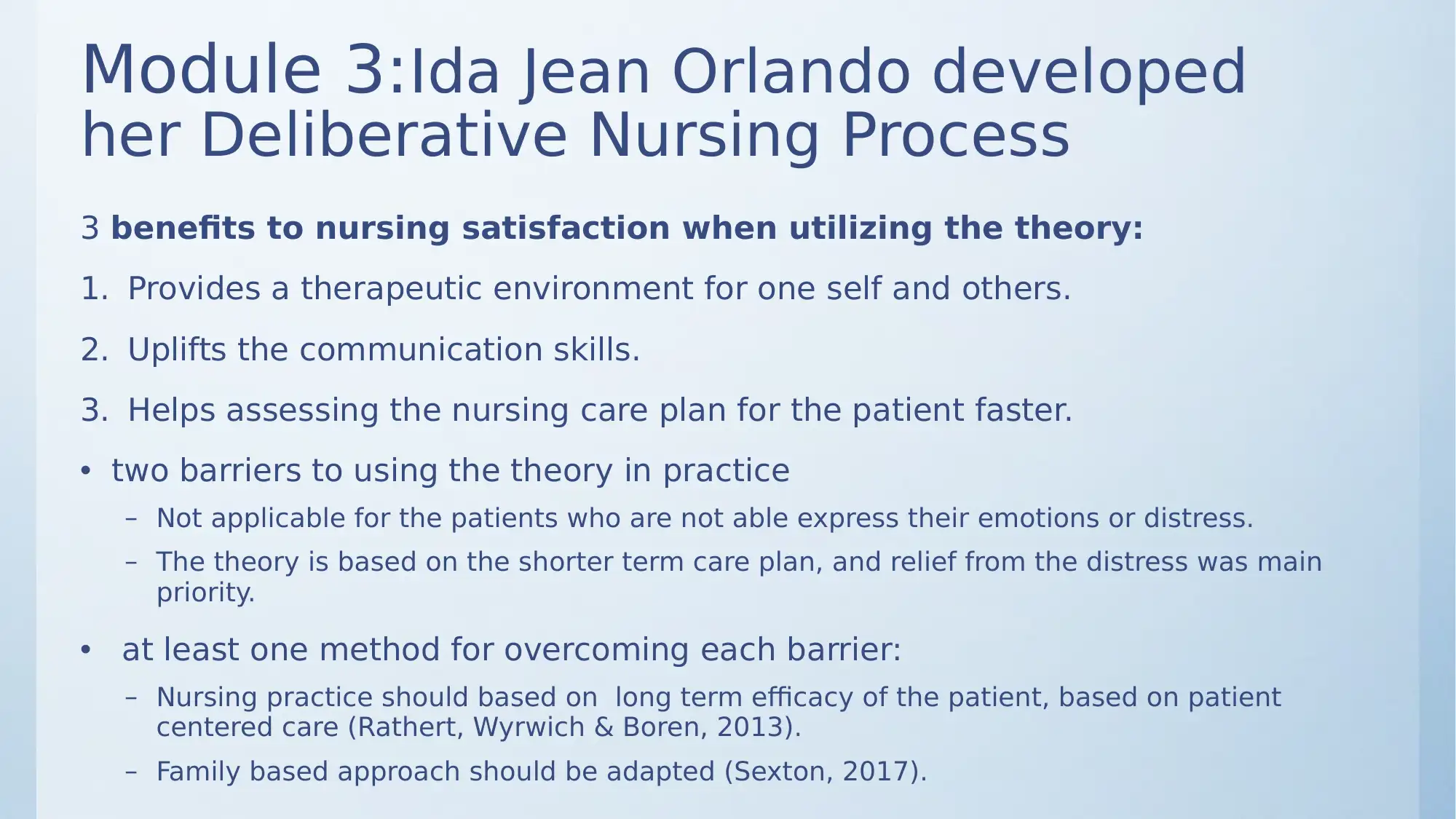
Module 3:Ida Jean Orlando developed
her Deliberative Nursing Process
3 benefits to nursing satisfaction when utilizing the theory:
1. Provides a therapeutic environment for one self and others.
2. Uplifts the communication skills.
3. Helps assessing the nursing care plan for the patient faster.
• two barriers to using the theory in practice
– Not applicable for the patients who are not able express their emotions or distress.
– The theory is based on the shorter term care plan, and relief from the distress was main
priority.
• at least one method for overcoming each barrier:
– Nursing practice should based on long term efficacy of the patient, based on patient
centered care (Rathert, Wyrwich & Boren, 2013).
– Family based approach should be adapted (Sexton, 2017).
her Deliberative Nursing Process
3 benefits to nursing satisfaction when utilizing the theory:
1. Provides a therapeutic environment for one self and others.
2. Uplifts the communication skills.
3. Helps assessing the nursing care plan for the patient faster.
• two barriers to using the theory in practice
– Not applicable for the patients who are not able express their emotions or distress.
– The theory is based on the shorter term care plan, and relief from the distress was main
priority.
• at least one method for overcoming each barrier:
– Nursing practice should based on long term efficacy of the patient, based on patient
centered care (Rathert, Wyrwich & Boren, 2013).
– Family based approach should be adapted (Sexton, 2017).
Paraphrase This Document
Need a fresh take? Get an instant paraphrase of this document with our AI Paraphraser
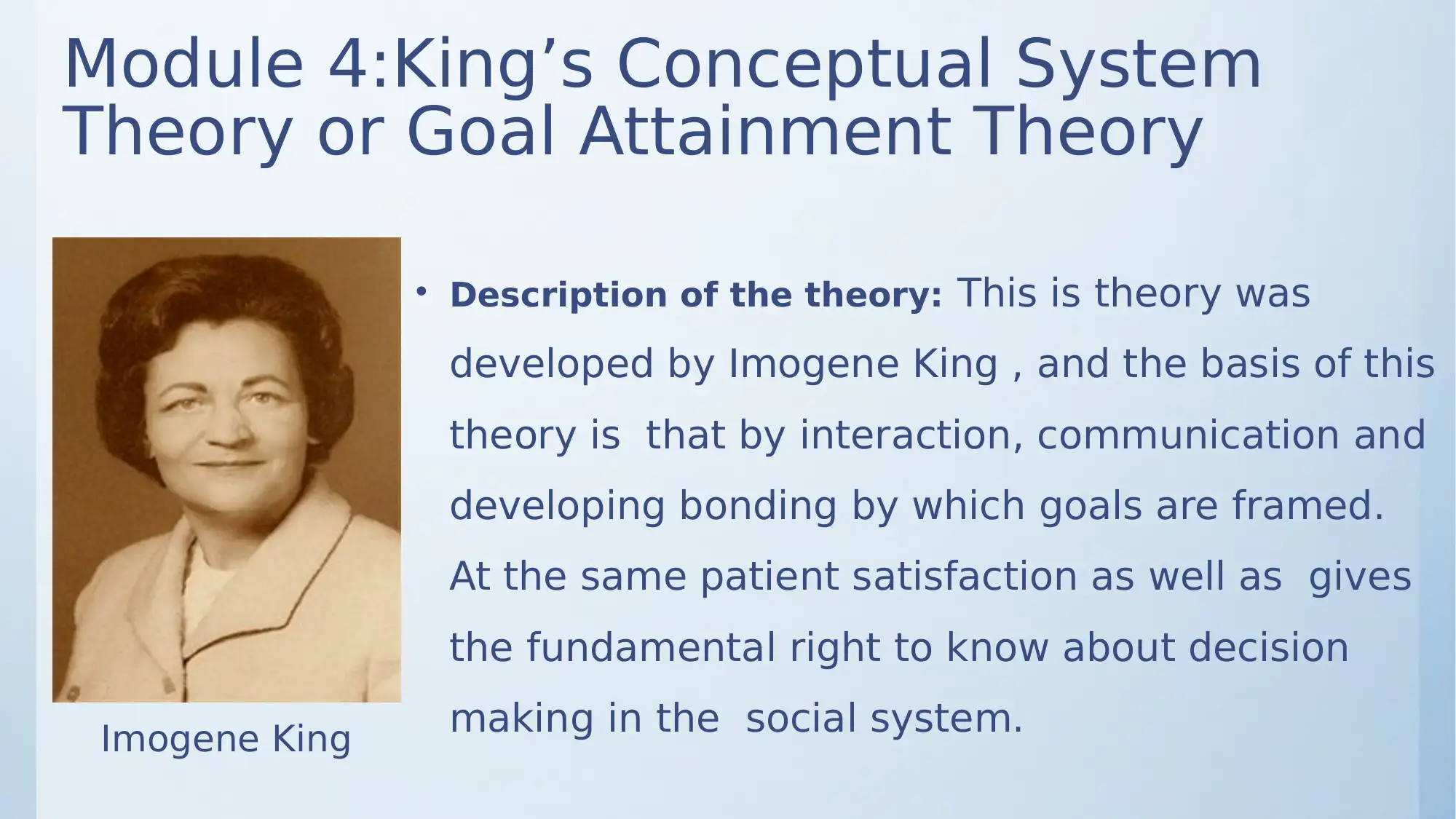
Module 4:King’s Conceptual System
Theory or Goal Attainment Theory
• Description of the theory: This is theory was
developed by Imogene King , and the basis of this
theory is that by interaction, communication and
developing bonding by which goals are framed.
At the same patient satisfaction as well as gives
the fundamental right to know about decision
making in the social system.Imogene King
Theory or Goal Attainment Theory
• Description of the theory: This is theory was
developed by Imogene King , and the basis of this
theory is that by interaction, communication and
developing bonding by which goals are framed.
At the same patient satisfaction as well as gives
the fundamental right to know about decision
making in the social system.Imogene King
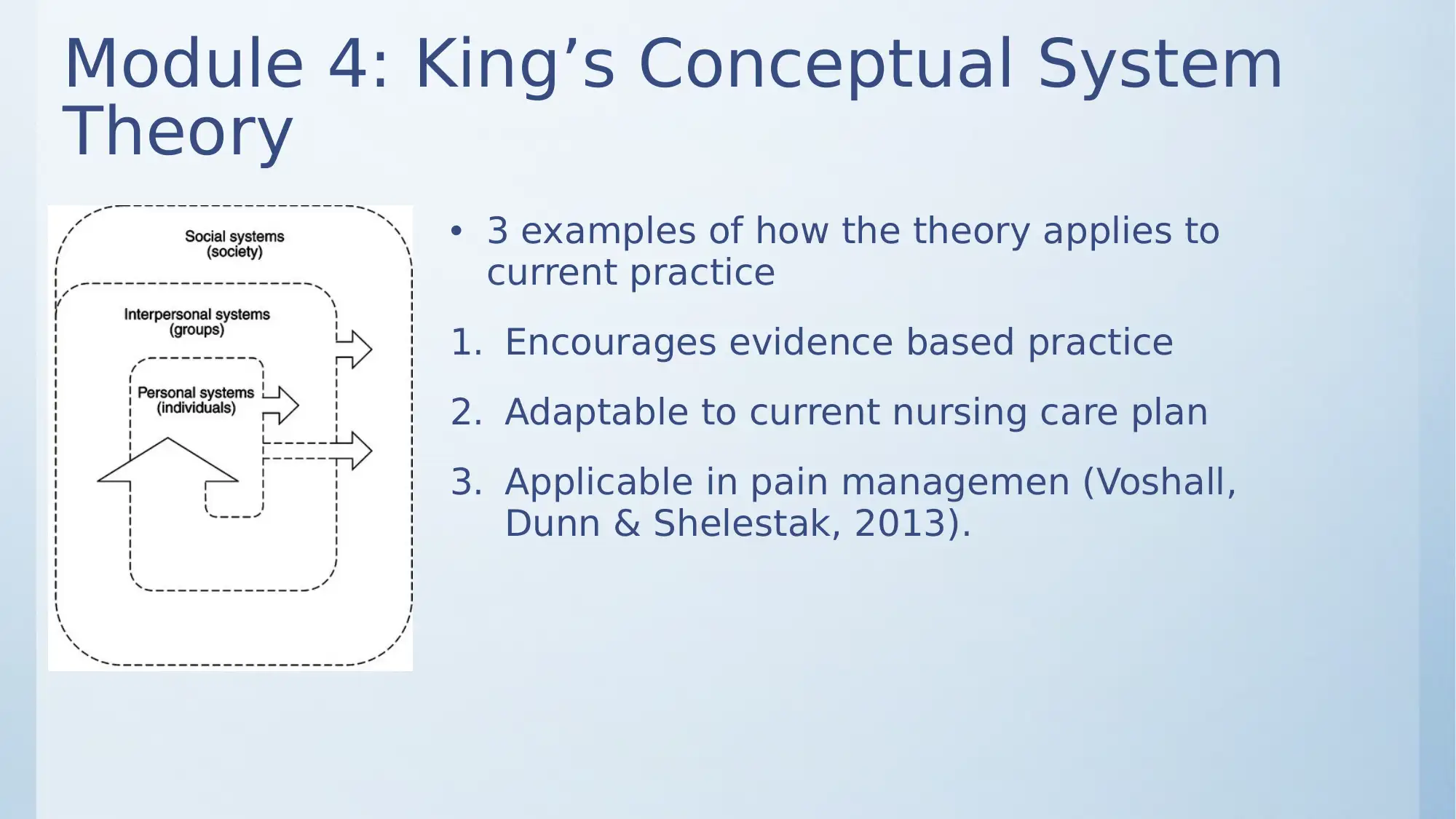
Module 4: King’s Conceptual System
Theory
• 3 examples of how the theory applies to
current practice
1. Encourages evidence based practice
2. Adaptable to current nursing care plan
3. Applicable in pain managemen (Voshall,
Dunn & Shelestak, 2013).
Theory
• 3 examples of how the theory applies to
current practice
1. Encourages evidence based practice
2. Adaptable to current nursing care plan
3. Applicable in pain managemen (Voshall,
Dunn & Shelestak, 2013).
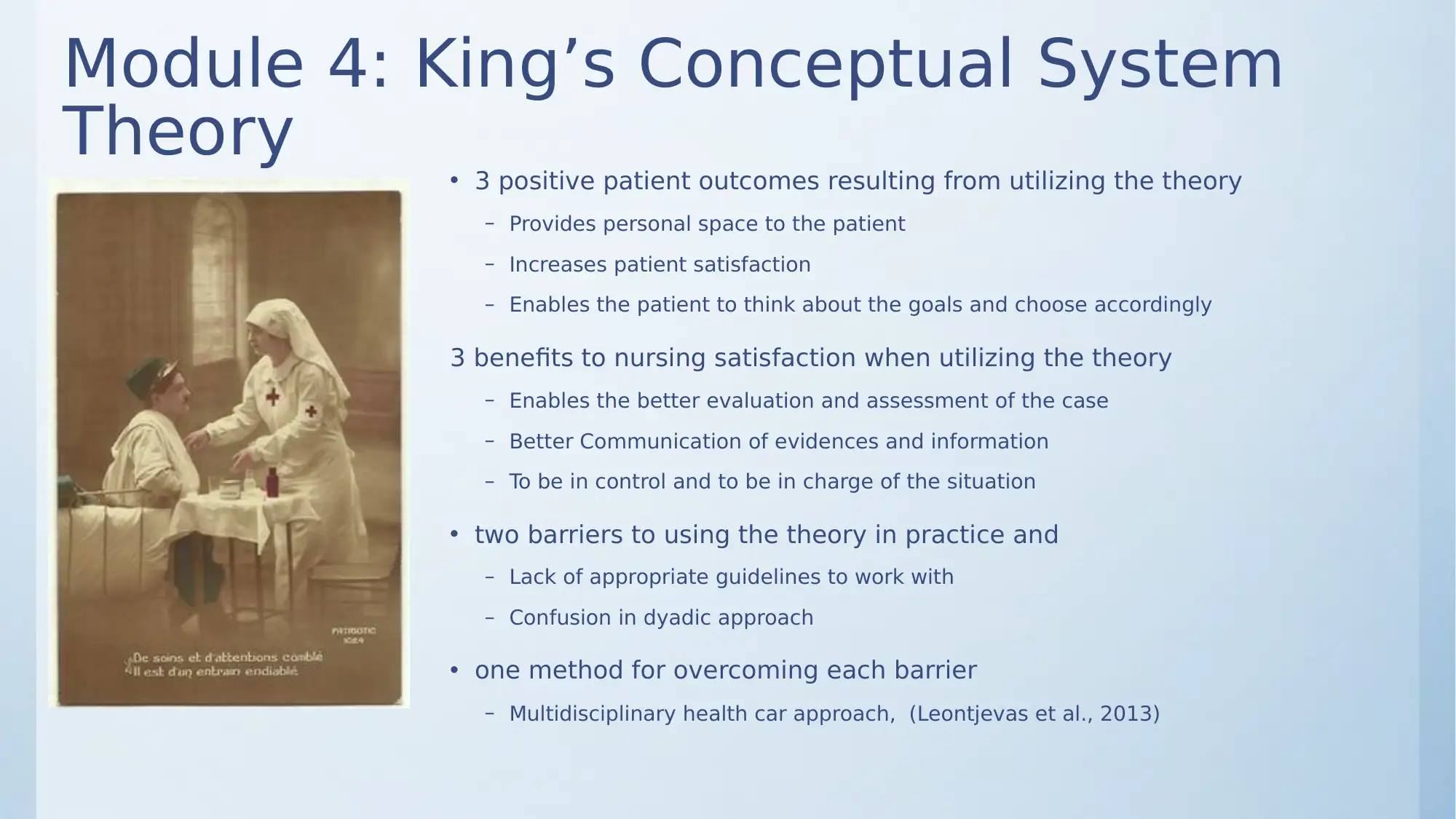
Module 4: King’s Conceptual System
Theory • 3 positive patient outcomes resulting from utilizing the theory
– Provides personal space to the patient
– Increases patient satisfaction
– Enables the patient to think about the goals and choose accordingly
3 benefits to nursing satisfaction when utilizing the theory
– Enables the better evaluation and assessment of the case
– Better Communication of evidences and information
– To be in control and to be in charge of the situation
• two barriers to using the theory in practice and
– Lack of appropriate guidelines to work with
– Confusion in dyadic approach
• one method for overcoming each barrier
– Multidisciplinary health car approach, (Leontjevas et al., 2013)
Theory • 3 positive patient outcomes resulting from utilizing the theory
– Provides personal space to the patient
– Increases patient satisfaction
– Enables the patient to think about the goals and choose accordingly
3 benefits to nursing satisfaction when utilizing the theory
– Enables the better evaluation and assessment of the case
– Better Communication of evidences and information
– To be in control and to be in charge of the situation
• two barriers to using the theory in practice and
– Lack of appropriate guidelines to work with
– Confusion in dyadic approach
• one method for overcoming each barrier
– Multidisciplinary health car approach, (Leontjevas et al., 2013)
Secure Best Marks with AI Grader
Need help grading? Try our AI Grader for instant feedback on your assignments.
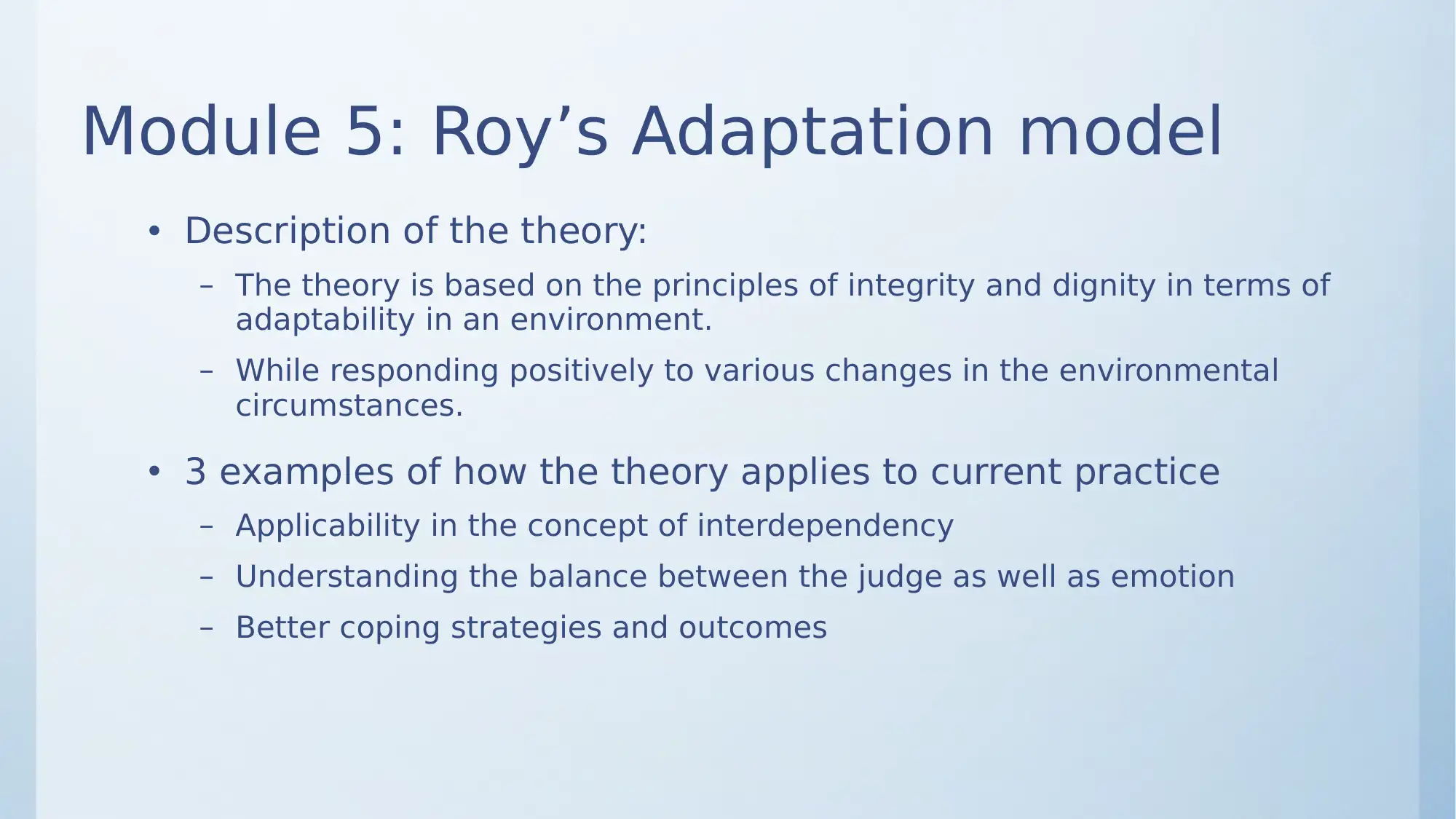
Module 5: Roy’s Adaptation model
• Description of the theory:
– The theory is based on the principles of integrity and dignity in terms of
adaptability in an environment.
– While responding positively to various changes in the environmental
circumstances.
• 3 examples of how the theory applies to current practice
– Applicability in the concept of interdependency
– Understanding the balance between the judge as well as emotion
– Better coping strategies and outcomes
• Description of the theory:
– The theory is based on the principles of integrity and dignity in terms of
adaptability in an environment.
– While responding positively to various changes in the environmental
circumstances.
• 3 examples of how the theory applies to current practice
– Applicability in the concept of interdependency
– Understanding the balance between the judge as well as emotion
– Better coping strategies and outcomes

Module 5: Roy’s Adaptation model
• 3 positive patient outcomes resulting from utilizing the theory
– Effective care to the patients
– Better understanding of the patient’s problems and dilemmas
– Better nurse patient understanding
3 benefits to nursing satisfaction when utilizing the theory
– Easy to understand
– Easy to apply
– Better approach to nursing care plan
• two barriers to using the theory in practice
– Generalized description
– Integration of multiple concepts.
• at least one method for overcoming each barrier
– Evidence based practice(Laska, Gurman & Wampold, 2014).
– Nursing methods based on proper guidance on the theory (Ursavaş, Karayurt
& İşeri,2014).
• 3 positive patient outcomes resulting from utilizing the theory
– Effective care to the patients
– Better understanding of the patient’s problems and dilemmas
– Better nurse patient understanding
3 benefits to nursing satisfaction when utilizing the theory
– Easy to understand
– Easy to apply
– Better approach to nursing care plan
• two barriers to using the theory in practice
– Generalized description
– Integration of multiple concepts.
• at least one method for overcoming each barrier
– Evidence based practice(Laska, Gurman & Wampold, 2014).
– Nursing methods based on proper guidance on the theory (Ursavaş, Karayurt
& İşeri,2014).
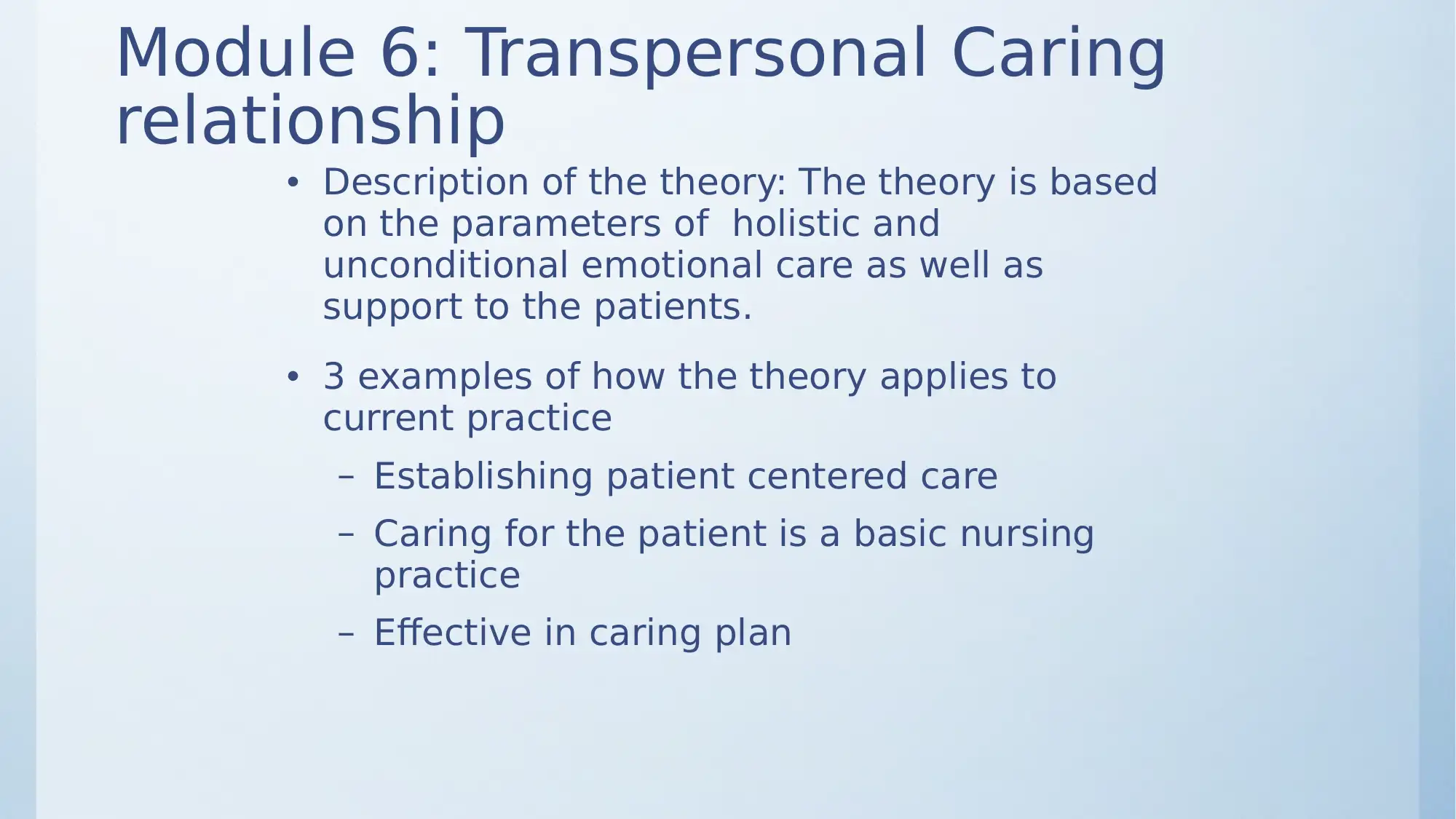
Module 6: Transpersonal Caring
relationship
• Description of the theory: The theory is based
on the parameters of holistic and
unconditional emotional care as well as
support to the patients.
• 3 examples of how the theory applies to
current practice
– Establishing patient centered care
– Caring for the patient is a basic nursing
practice
– Effective in caring plan
relationship
• Description of the theory: The theory is based
on the parameters of holistic and
unconditional emotional care as well as
support to the patients.
• 3 examples of how the theory applies to
current practice
– Establishing patient centered care
– Caring for the patient is a basic nursing
practice
– Effective in caring plan
Paraphrase This Document
Need a fresh take? Get an instant paraphrase of this document with our AI Paraphraser
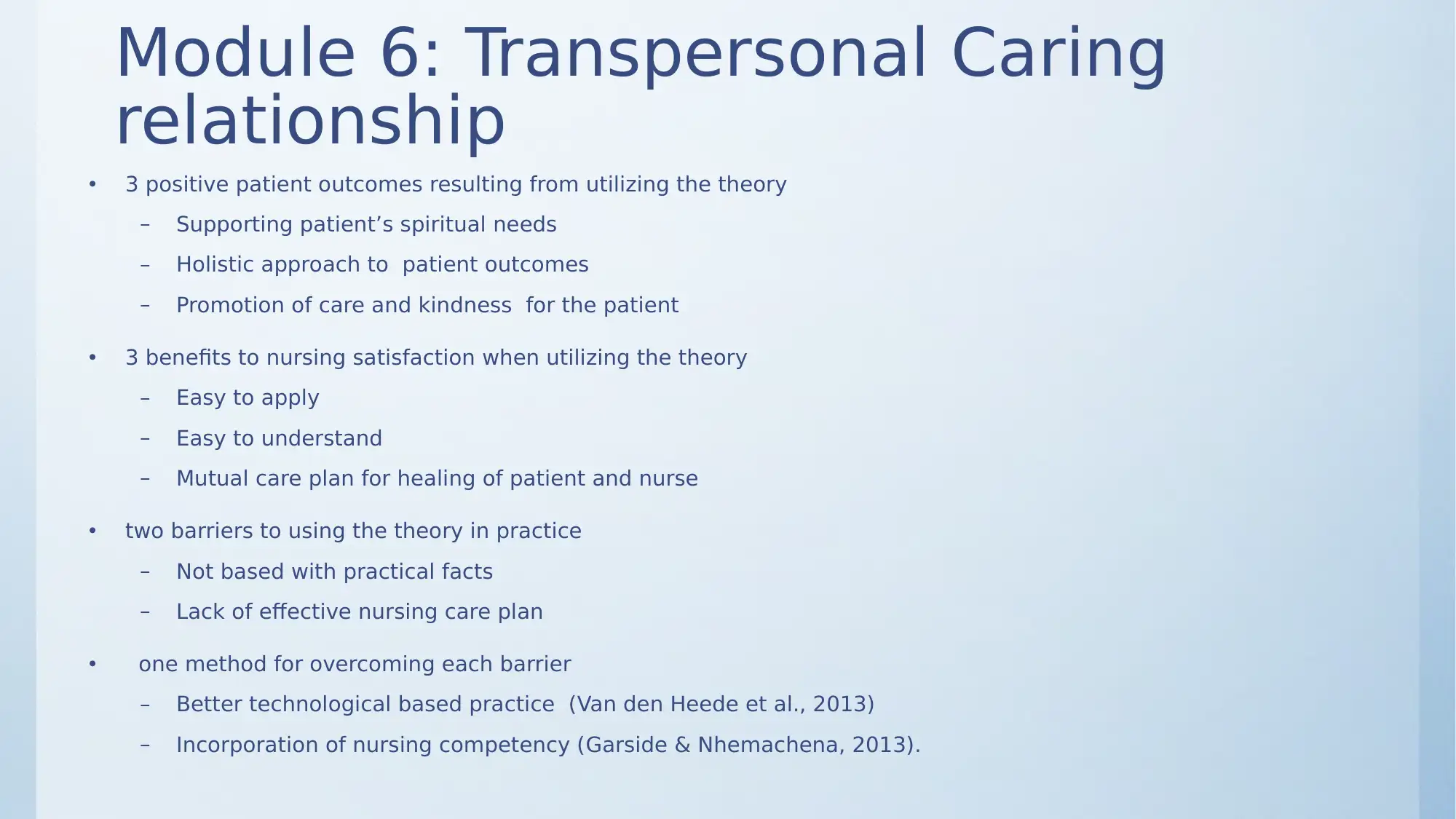
Module 6: Transpersonal Caring
relationship
• 3 positive patient outcomes resulting from utilizing the theory
– Supporting patient’s spiritual needs
– Holistic approach to patient outcomes
– Promotion of care and kindness for the patient
• 3 benefits to nursing satisfaction when utilizing the theory
– Easy to apply
– Easy to understand
– Mutual care plan for healing of patient and nurse
• two barriers to using the theory in practice
– Not based with practical facts
– Lack of effective nursing care plan
• one method for overcoming each barrier
– Better technological based practice (Van den Heede et al., 2013)
– Incorporation of nursing competency (Garside & Nhemachena, 2013).
relationship
• 3 positive patient outcomes resulting from utilizing the theory
– Supporting patient’s spiritual needs
– Holistic approach to patient outcomes
– Promotion of care and kindness for the patient
• 3 benefits to nursing satisfaction when utilizing the theory
– Easy to apply
– Easy to understand
– Mutual care plan for healing of patient and nurse
• two barriers to using the theory in practice
– Not based with practical facts
– Lack of effective nursing care plan
• one method for overcoming each barrier
– Better technological based practice (Van den Heede et al., 2013)
– Incorporation of nursing competency (Garside & Nhemachena, 2013).

Module 7:Parse's theory
• Description of the theory: It is based on the
uplifting the quality of life when comes to
the nursing practice. It is also known as the
Human becoming theory.
• 3 examples of how the theory applies to
current practice
– Understanding the principles of co-existing
– Merging the values of modern techniques with the
environmental value
– Expression of freedom
• Description of the theory: It is based on the
uplifting the quality of life when comes to
the nursing practice. It is also known as the
Human becoming theory.
• 3 examples of how the theory applies to
current practice
– Understanding the principles of co-existing
– Merging the values of modern techniques with the
environmental value
– Expression of freedom
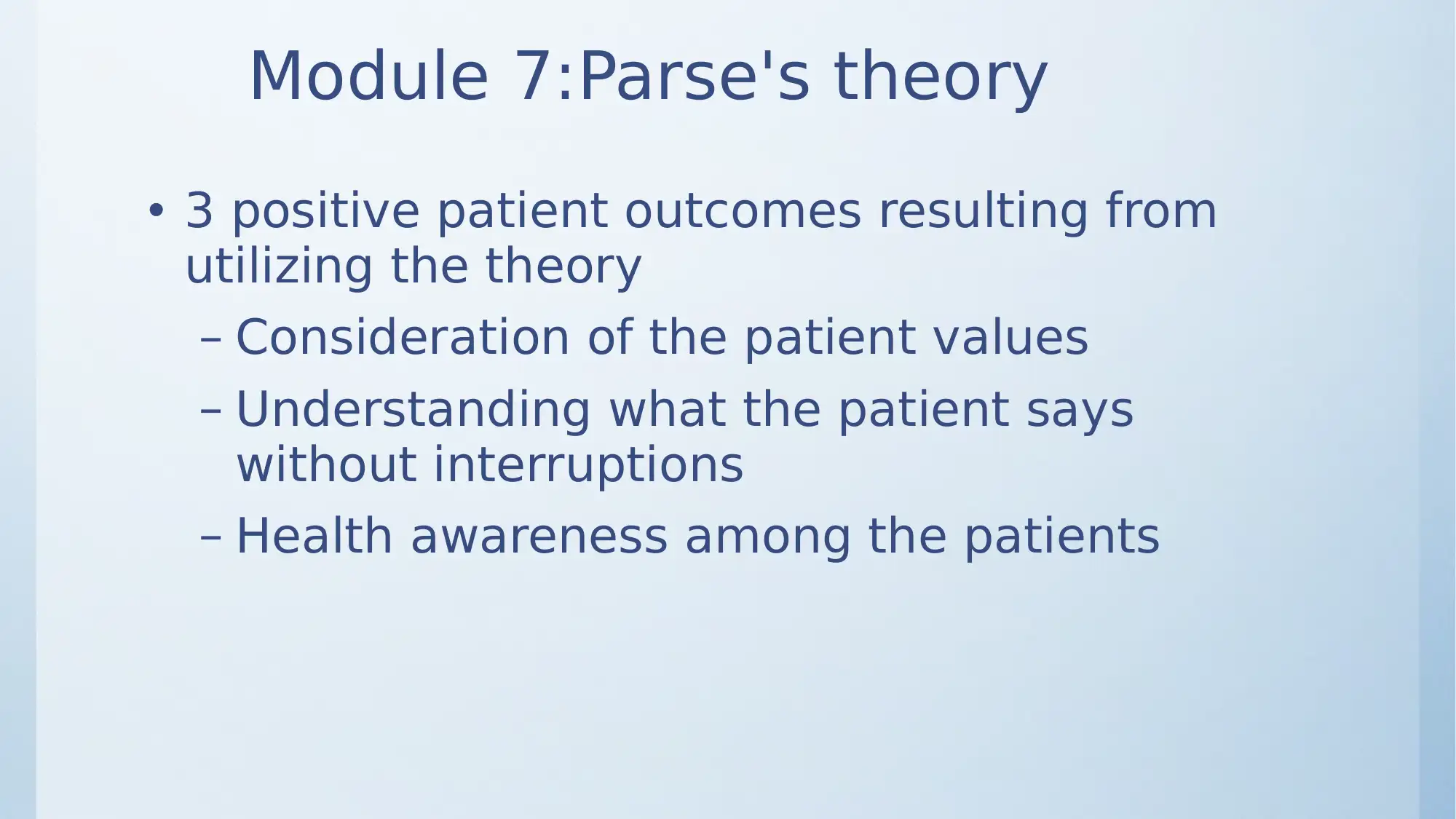
Module 7:Parse's theory
• 3 positive patient outcomes resulting from
utilizing the theory
– Consideration of the patient values
– Understanding what the patient says
without interruptions
– Health awareness among the patients
• 3 positive patient outcomes resulting from
utilizing the theory
– Consideration of the patient values
– Understanding what the patient says
without interruptions
– Health awareness among the patients
Secure Best Marks with AI Grader
Need help grading? Try our AI Grader for instant feedback on your assignments.
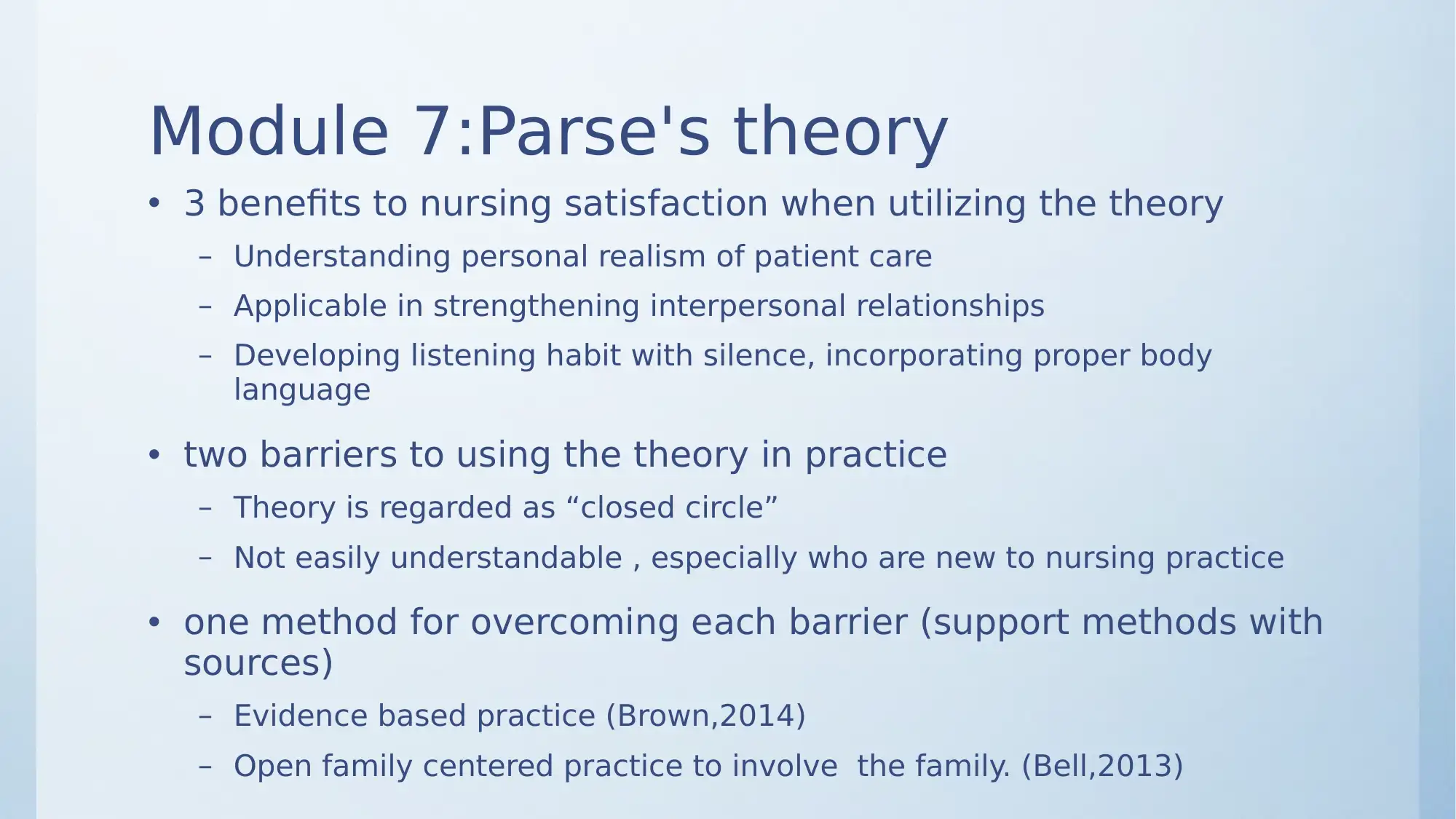
Module 7:Parse's theory
• 3 benefits to nursing satisfaction when utilizing the theory
– Understanding personal realism of patient care
– Applicable in strengthening interpersonal relationships
– Developing listening habit with silence, incorporating proper body
language
• two barriers to using the theory in practice
– Theory is regarded as “closed circle”
– Not easily understandable , especially who are new to nursing practice
• one method for overcoming each barrier (support methods with
sources)
– Evidence based practice (Brown,2014)
– Open family centered practice to involve the family. (Bell,2013)
• 3 benefits to nursing satisfaction when utilizing the theory
– Understanding personal realism of patient care
– Applicable in strengthening interpersonal relationships
– Developing listening habit with silence, incorporating proper body
language
• two barriers to using the theory in practice
– Theory is regarded as “closed circle”
– Not easily understandable , especially who are new to nursing practice
• one method for overcoming each barrier (support methods with
sources)
– Evidence based practice (Brown,2014)
– Open family centered practice to involve the family. (Bell,2013)
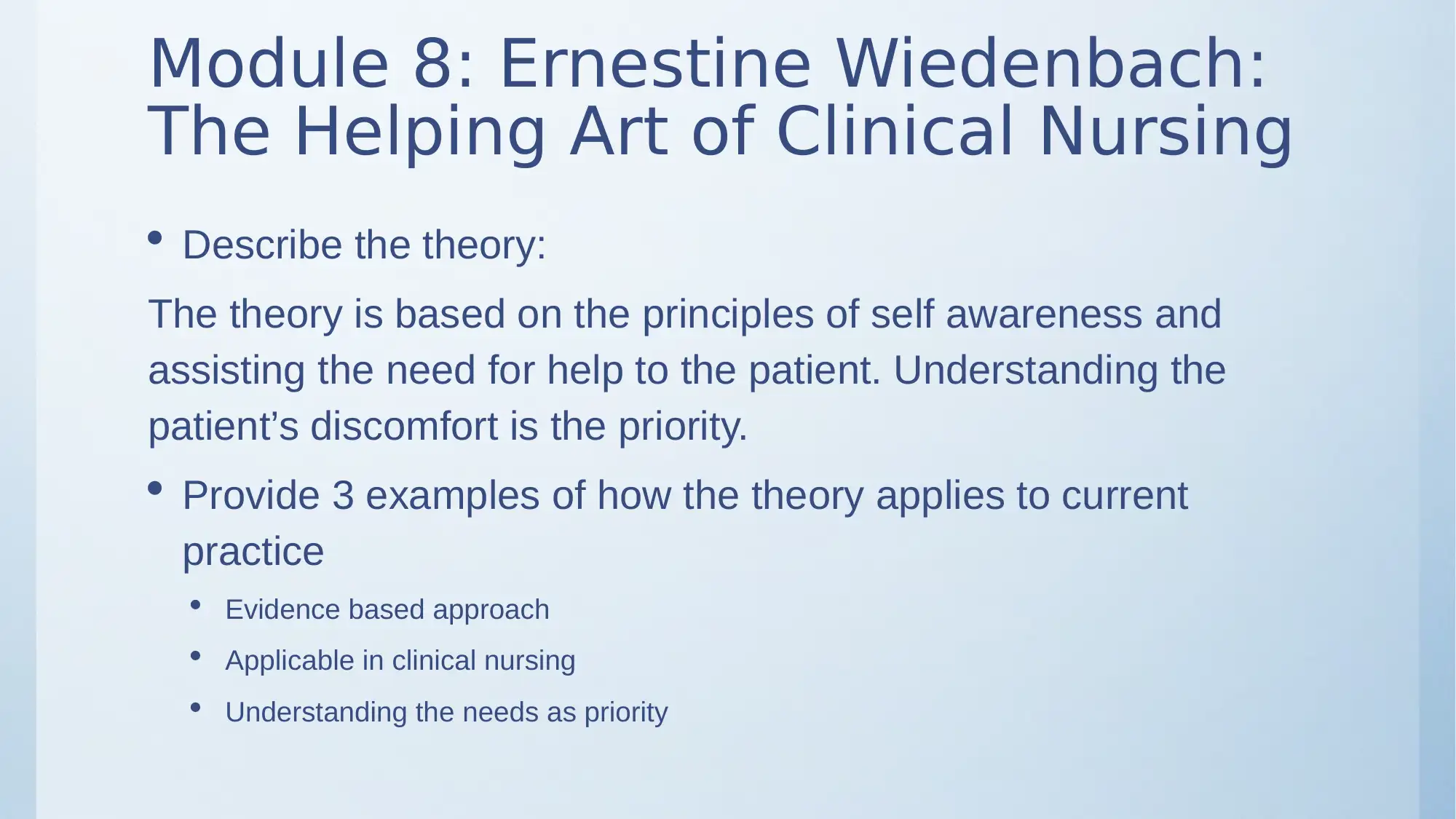
Module 8: Ernestine Wiedenbach:
The Helping Art of Clinical Nursing
Describe the theory:
The theory is based on the principles of self awareness and
assisting the need for help to the patient. Understanding the
patient’s discomfort is the priority.
Provide 3 examples of how the theory applies to current
practice
Evidence based approach
Applicable in clinical nursing
Understanding the needs as priority
The Helping Art of Clinical Nursing
Describe the theory:
The theory is based on the principles of self awareness and
assisting the need for help to the patient. Understanding the
patient’s discomfort is the priority.
Provide 3 examples of how the theory applies to current
practice
Evidence based approach
Applicable in clinical nursing
Understanding the needs as priority
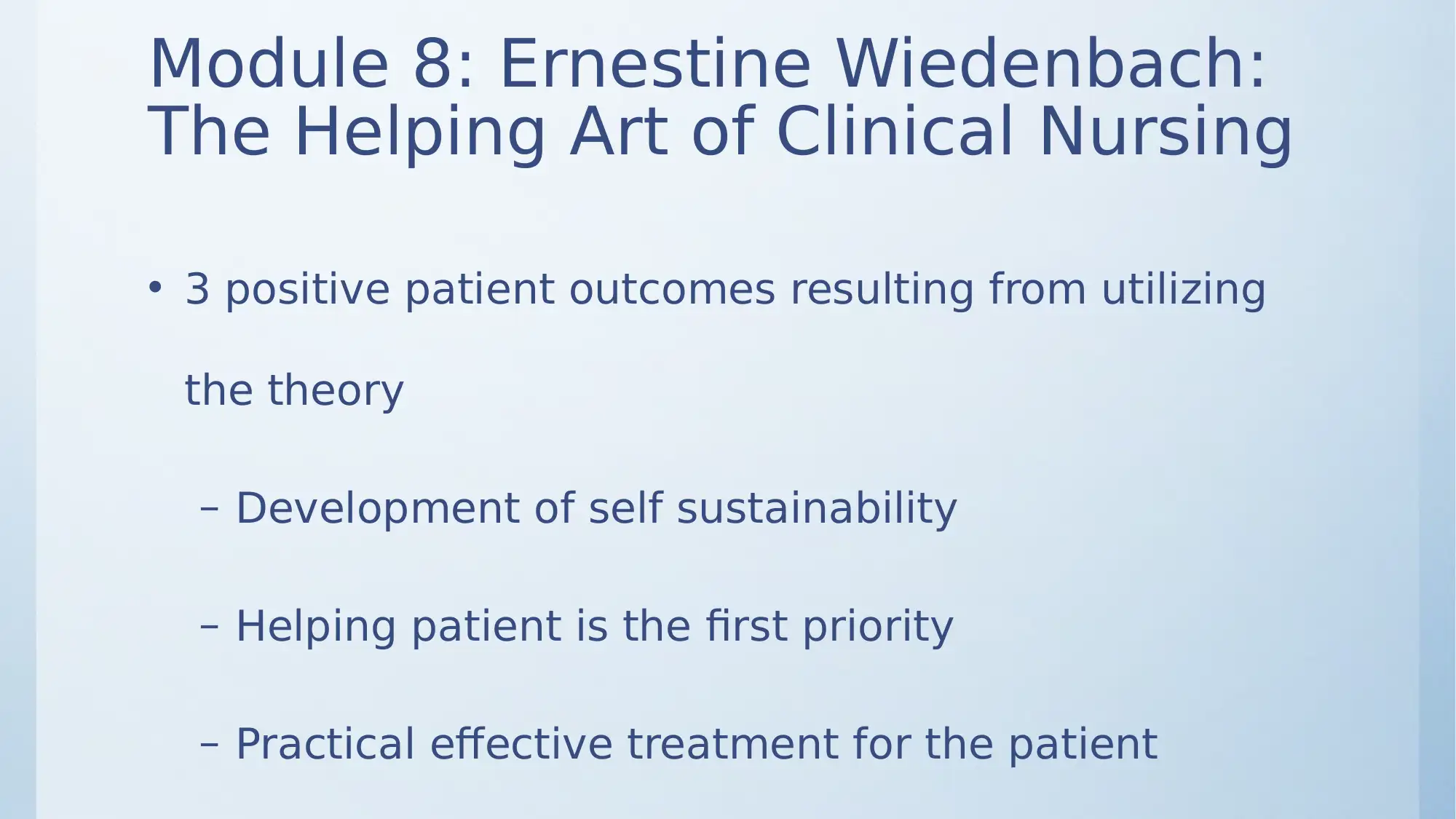
Module 8: Ernestine Wiedenbach:
The Helping Art of Clinical Nursing
• 3 positive patient outcomes resulting from utilizing
the theory
– Development of self sustainability
– Helping patient is the first priority
– Practical effective treatment for the patient
The Helping Art of Clinical Nursing
• 3 positive patient outcomes resulting from utilizing
the theory
– Development of self sustainability
– Helping patient is the first priority
– Practical effective treatment for the patient
Paraphrase This Document
Need a fresh take? Get an instant paraphrase of this document with our AI Paraphraser
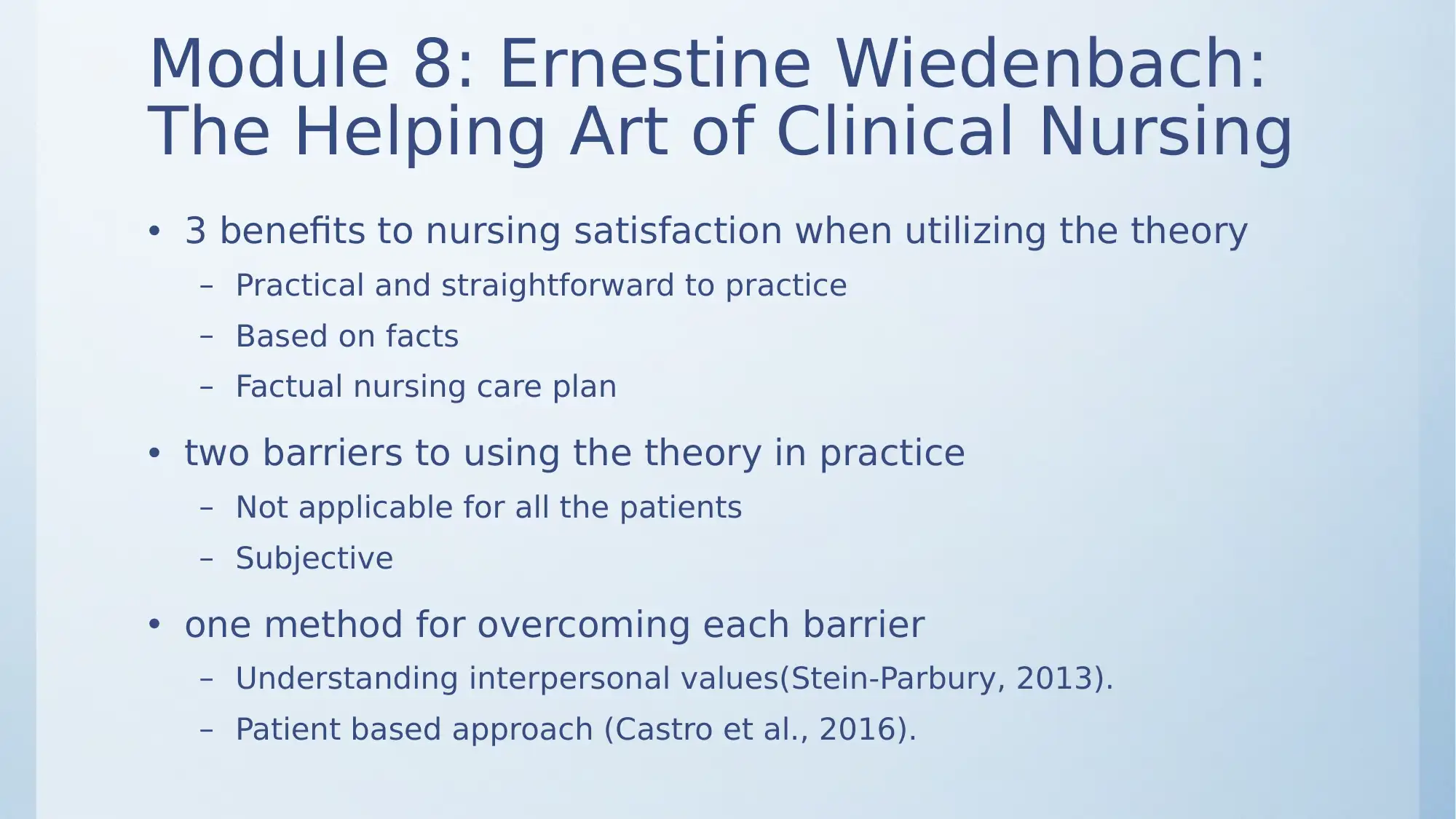
Module 8: Ernestine Wiedenbach:
The Helping Art of Clinical Nursing
• 3 benefits to nursing satisfaction when utilizing the theory
– Practical and straightforward to practice
– Based on facts
– Factual nursing care plan
• two barriers to using the theory in practice
– Not applicable for all the patients
– Subjective
• one method for overcoming each barrier
– Understanding interpersonal values(Stein-Parbury, 2013).
– Patient based approach (Castro et al., 2016).
The Helping Art of Clinical Nursing
• 3 benefits to nursing satisfaction when utilizing the theory
– Practical and straightforward to practice
– Based on facts
– Factual nursing care plan
• two barriers to using the theory in practice
– Not applicable for all the patients
– Subjective
• one method for overcoming each barrier
– Understanding interpersonal values(Stein-Parbury, 2013).
– Patient based approach (Castro et al., 2016).

References
• Awalkhan, A., & Muhammad, D. (2016). Application of Nightingale
Nursing Theory to the Care of Patient with Colostomy. European
Journal of Clinical and Biomedical Sciences, 2(6), 97-101.
• Bell, J. M. (2013). Family nursing is more than family centered care.
• Brown, C. G. (2014). The Iowa Model of Evidence-Based Practice to
Promote Quality Care: An Illustrated Example in Oncology Nursing.
Clinical Journal of Oncology Nursing, 18(2).
• Button, D., Harrington, A., & Belan, I. (2014). E-learning &
information communication technology (ICT) in nursing education: A
review of the literature. Nurse education today, 34(10), 1311-1323.
• Awalkhan, A., & Muhammad, D. (2016). Application of Nightingale
Nursing Theory to the Care of Patient with Colostomy. European
Journal of Clinical and Biomedical Sciences, 2(6), 97-101.
• Bell, J. M. (2013). Family nursing is more than family centered care.
• Brown, C. G. (2014). The Iowa Model of Evidence-Based Practice to
Promote Quality Care: An Illustrated Example in Oncology Nursing.
Clinical Journal of Oncology Nursing, 18(2).
• Button, D., Harrington, A., & Belan, I. (2014). E-learning &
information communication technology (ICT) in nursing education: A
review of the literature. Nurse education today, 34(10), 1311-1323.
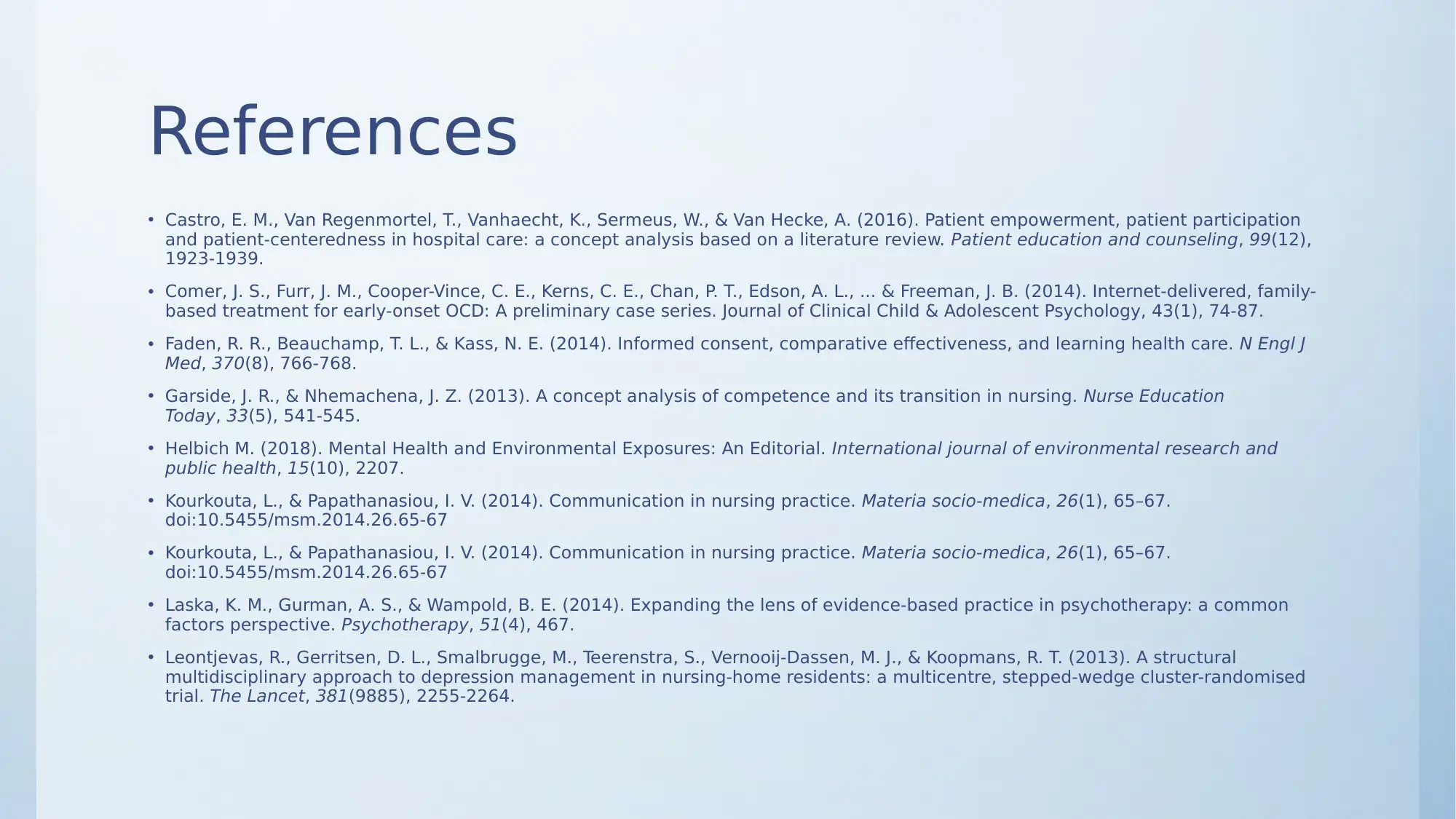
References
• Castro, E. M., Van Regenmortel, T., Vanhaecht, K., Sermeus, W., & Van Hecke, A. (2016). Patient empowerment, patient participation
and patient-centeredness in hospital care: a concept analysis based on a literature review. Patient education and counseling, 99(12),
1923-1939.
• Comer, J. S., Furr, J. M., Cooper-Vince, C. E., Kerns, C. E., Chan, P. T., Edson, A. L., ... & Freeman, J. B. (2014). Internet-delivered, family-
based treatment for early-onset OCD: A preliminary case series. Journal of Clinical Child & Adolescent Psychology, 43(1), 74-87.
• Faden, R. R., Beauchamp, T. L., & Kass, N. E. (2014). Informed consent, comparative effectiveness, and learning health care. N Engl J
Med, 370(8), 766-768.
• Garside, J. R., & Nhemachena, J. Z. (2013). A concept analysis of competence and its transition in nursing. Nurse Education
Today, 33(5), 541-545.
• Helbich M. (2018). Mental Health and Environmental Exposures: An Editorial. International journal of environmental research and
public health, 15(10), 2207.
• Kourkouta, L., & Papathanasiou, I. V. (2014). Communication in nursing practice. Materia socio-medica, 26(1), 65–67.
doi:10.5455/msm.2014.26.65-67
• Kourkouta, L., & Papathanasiou, I. V. (2014). Communication in nursing practice. Materia socio-medica, 26(1), 65–67.
doi:10.5455/msm.2014.26.65-67
• Laska, K. M., Gurman, A. S., & Wampold, B. E. (2014). Expanding the lens of evidence-based practice in psychotherapy: a common
factors perspective. Psychotherapy, 51(4), 467.
• Leontjevas, R., Gerritsen, D. L., Smalbrugge, M., Teerenstra, S., Vernooij-Dassen, M. J., & Koopmans, R. T. (2013). A structural
multidisciplinary approach to depression management in nursing-home residents: a multicentre, stepped-wedge cluster-randomised
trial. The Lancet, 381(9885), 2255-2264.
• Castro, E. M., Van Regenmortel, T., Vanhaecht, K., Sermeus, W., & Van Hecke, A. (2016). Patient empowerment, patient participation
and patient-centeredness in hospital care: a concept analysis based on a literature review. Patient education and counseling, 99(12),
1923-1939.
• Comer, J. S., Furr, J. M., Cooper-Vince, C. E., Kerns, C. E., Chan, P. T., Edson, A. L., ... & Freeman, J. B. (2014). Internet-delivered, family-
based treatment for early-onset OCD: A preliminary case series. Journal of Clinical Child & Adolescent Psychology, 43(1), 74-87.
• Faden, R. R., Beauchamp, T. L., & Kass, N. E. (2014). Informed consent, comparative effectiveness, and learning health care. N Engl J
Med, 370(8), 766-768.
• Garside, J. R., & Nhemachena, J. Z. (2013). A concept analysis of competence and its transition in nursing. Nurse Education
Today, 33(5), 541-545.
• Helbich M. (2018). Mental Health and Environmental Exposures: An Editorial. International journal of environmental research and
public health, 15(10), 2207.
• Kourkouta, L., & Papathanasiou, I. V. (2014). Communication in nursing practice. Materia socio-medica, 26(1), 65–67.
doi:10.5455/msm.2014.26.65-67
• Kourkouta, L., & Papathanasiou, I. V. (2014). Communication in nursing practice. Materia socio-medica, 26(1), 65–67.
doi:10.5455/msm.2014.26.65-67
• Laska, K. M., Gurman, A. S., & Wampold, B. E. (2014). Expanding the lens of evidence-based practice in psychotherapy: a common
factors perspective. Psychotherapy, 51(4), 467.
• Leontjevas, R., Gerritsen, D. L., Smalbrugge, M., Teerenstra, S., Vernooij-Dassen, M. J., & Koopmans, R. T. (2013). A structural
multidisciplinary approach to depression management in nursing-home residents: a multicentre, stepped-wedge cluster-randomised
trial. The Lancet, 381(9885), 2255-2264.
Secure Best Marks with AI Grader
Need help grading? Try our AI Grader for instant feedback on your assignments.

References
• trial. The Lancet, 381(9885), 2255-2264.
• Medeiros, A. B. D. A., Enders, B. C., & Lira, A. L. B. D. C. (2015). The Florence Nightingale’s environmental theory: A critical analysis. Escola
Anna Nery, 19(3), 518-524.
• Melnyk, B. M., Gallagher‐Ford, L., Long, L. E., & Fineout‐Overholt, E. (2014). The establishment of evidence‐based practice competencies for
practicing registered nurses and advanced practice nurses in real‐world clinical settings: Proficiencies to improve healthcare quality,
reliability, patient outcomes, and costs. Worldviews on Evidence‐Based Nursing, 11(1), 5-15.
• Radtke, K. (2013). Improving patient satisfaction with nursing communication using bedside shift report. Clinical Nurse Specialist, 27(1), 19-
25.
• Rathert, C., Wyrwich, M. D., & Boren, S. A. (2013). Patient-centered care and outcomes: a systematic review of the literature. Medical Care
Research and Review, 70(4), 351-379.
• Stein-Parbury, J. (2013). Patient and person: Interpersonal skills in nursing. Elsevier Health Sciences.
• Ursavaş, F. E., Karayurt, Ö., & İşeri, Ö. (2014). Nursing Approach Based on Roy Adaptation Model in a Patient Undergoing Breast Conserving
Surgery for Breast Cancer. The journal of breast health, 10(3), 134–140. doi:10.5152/tjbh.2014.1910
• Van den Heede, K., Florquin, M., Bruyneel, L., Aiken, L., Diya, L., Lesaffre, E., & Sermeus, W. (2013). Effective strategies for nurse retention in
acute hospitals: a mixed method study. International Journal of Nursing Studies, 50(2), 185-194.
• Voshall, B., Dunn, K. S., & Shelestak, D. (2013). Knowledge and attitudes of pain management among nursing faculty. Pain Management
Nursing, 14(4), e226-e235.
• Webster, D. (2013). Promoting therapeutic communication and patient-centered care using standardized patients. Journal of Nursing
Education, 52(11), 645-648.
• Wong, C. A., Cummings, G. G., & Ducharme, L. (2013). The relationship between nursing leadership and patient outcomes: a systematic
review update. Journal of nursing management, 21(5), 709-724.
• trial. The Lancet, 381(9885), 2255-2264.
• Medeiros, A. B. D. A., Enders, B. C., & Lira, A. L. B. D. C. (2015). The Florence Nightingale’s environmental theory: A critical analysis. Escola
Anna Nery, 19(3), 518-524.
• Melnyk, B. M., Gallagher‐Ford, L., Long, L. E., & Fineout‐Overholt, E. (2014). The establishment of evidence‐based practice competencies for
practicing registered nurses and advanced practice nurses in real‐world clinical settings: Proficiencies to improve healthcare quality,
reliability, patient outcomes, and costs. Worldviews on Evidence‐Based Nursing, 11(1), 5-15.
• Radtke, K. (2013). Improving patient satisfaction with nursing communication using bedside shift report. Clinical Nurse Specialist, 27(1), 19-
25.
• Rathert, C., Wyrwich, M. D., & Boren, S. A. (2013). Patient-centered care and outcomes: a systematic review of the literature. Medical Care
Research and Review, 70(4), 351-379.
• Stein-Parbury, J. (2013). Patient and person: Interpersonal skills in nursing. Elsevier Health Sciences.
• Ursavaş, F. E., Karayurt, Ö., & İşeri, Ö. (2014). Nursing Approach Based on Roy Adaptation Model in a Patient Undergoing Breast Conserving
Surgery for Breast Cancer. The journal of breast health, 10(3), 134–140. doi:10.5152/tjbh.2014.1910
• Van den Heede, K., Florquin, M., Bruyneel, L., Aiken, L., Diya, L., Lesaffre, E., & Sermeus, W. (2013). Effective strategies for nurse retention in
acute hospitals: a mixed method study. International Journal of Nursing Studies, 50(2), 185-194.
• Voshall, B., Dunn, K. S., & Shelestak, D. (2013). Knowledge and attitudes of pain management among nursing faculty. Pain Management
Nursing, 14(4), e226-e235.
• Webster, D. (2013). Promoting therapeutic communication and patient-centered care using standardized patients. Journal of Nursing
Education, 52(11), 645-648.
• Wong, C. A., Cummings, G. G., & Ducharme, L. (2013). The relationship between nursing leadership and patient outcomes: a systematic
review update. Journal of nursing management, 21(5), 709-724.

THANK YOU
1 out of 30
Related Documents
Your All-in-One AI-Powered Toolkit for Academic Success.
+13062052269
info@desklib.com
Available 24*7 on WhatsApp / Email
![[object Object]](/_next/static/media/star-bottom.7253800d.svg)
Unlock your academic potential
© 2024 | Zucol Services PVT LTD | All rights reserved.





